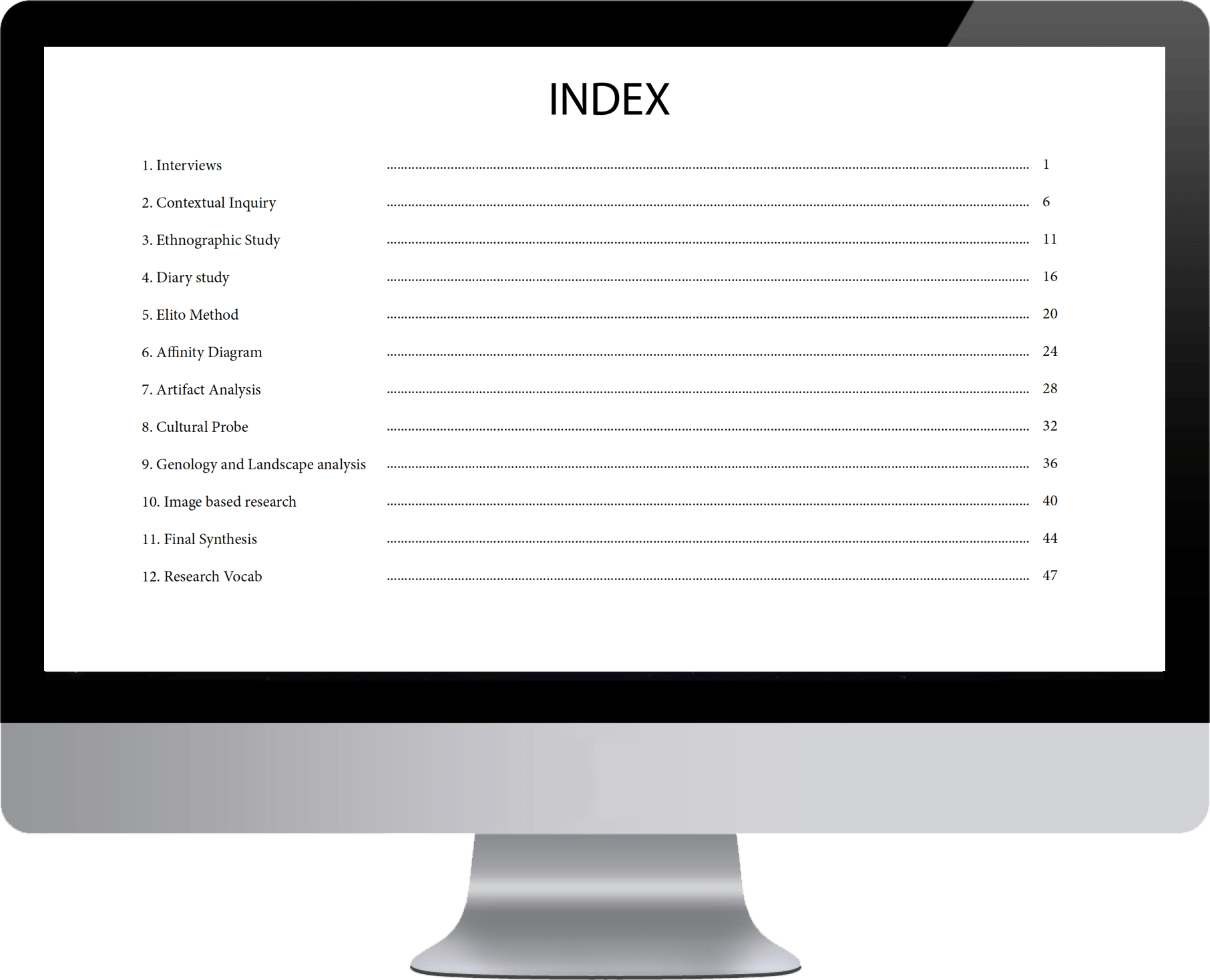Digital Ethnography
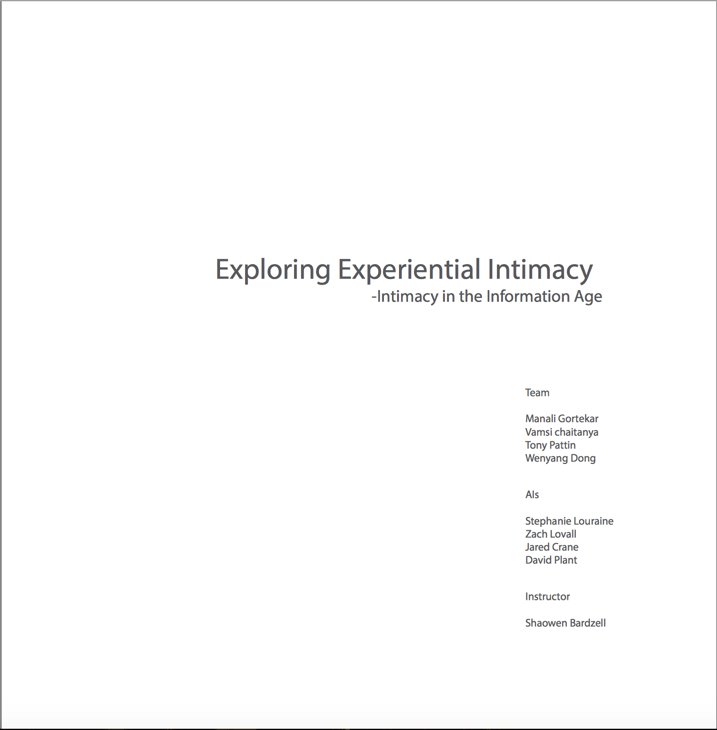
Slide title
1. Prompt
Button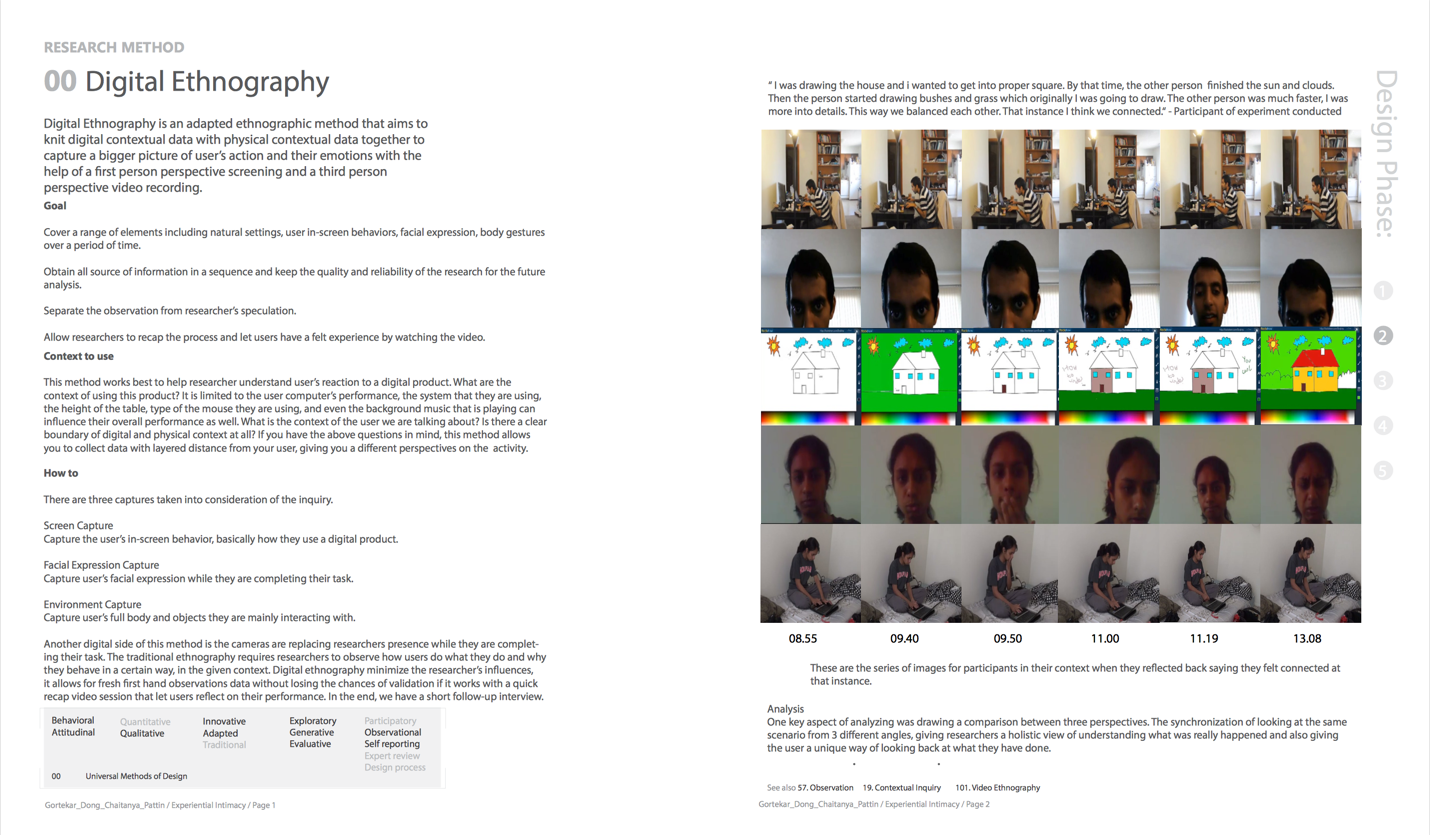
Slide title
2. New Method Invention
Button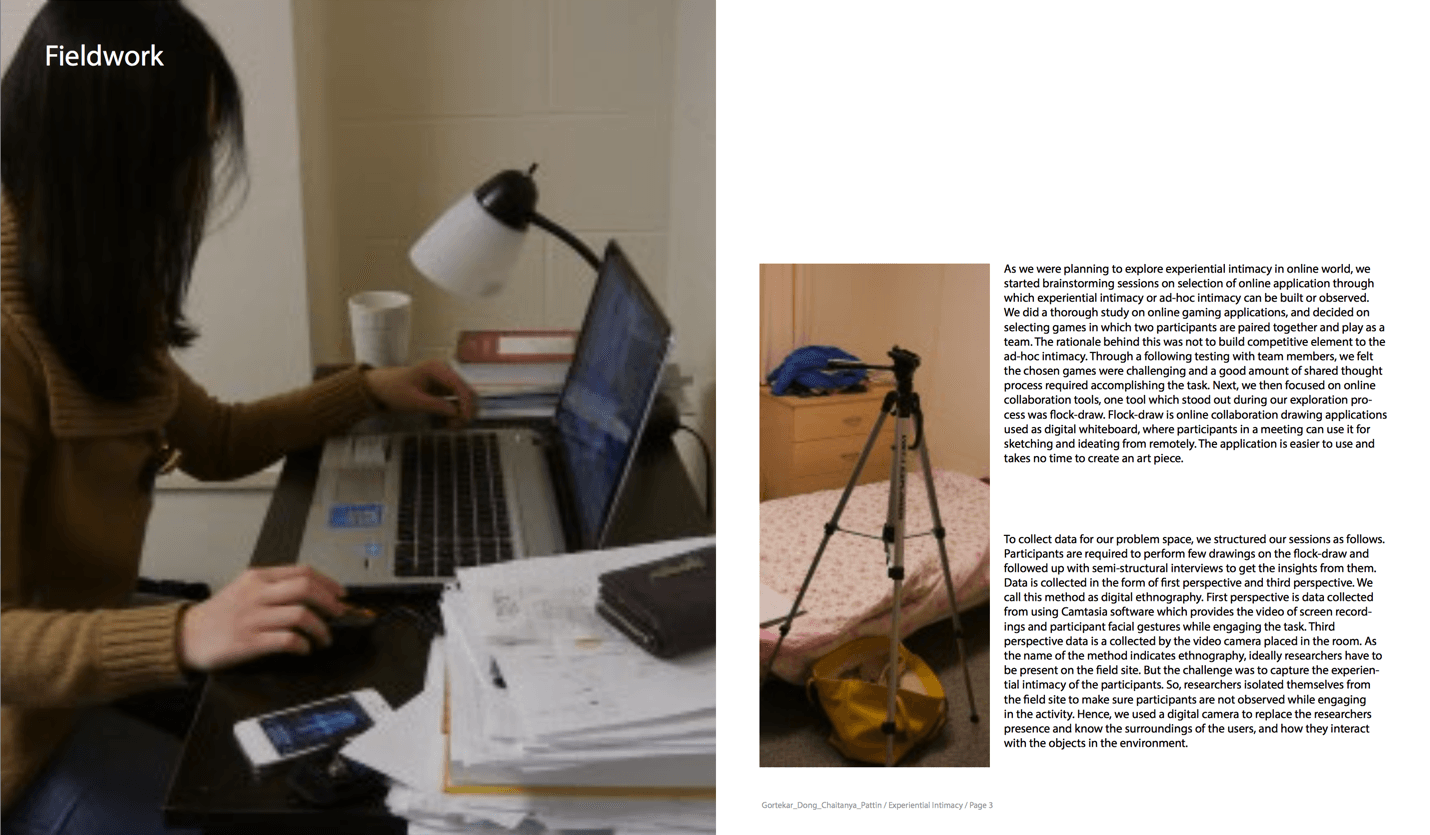
Slide title
3. Field Work
Button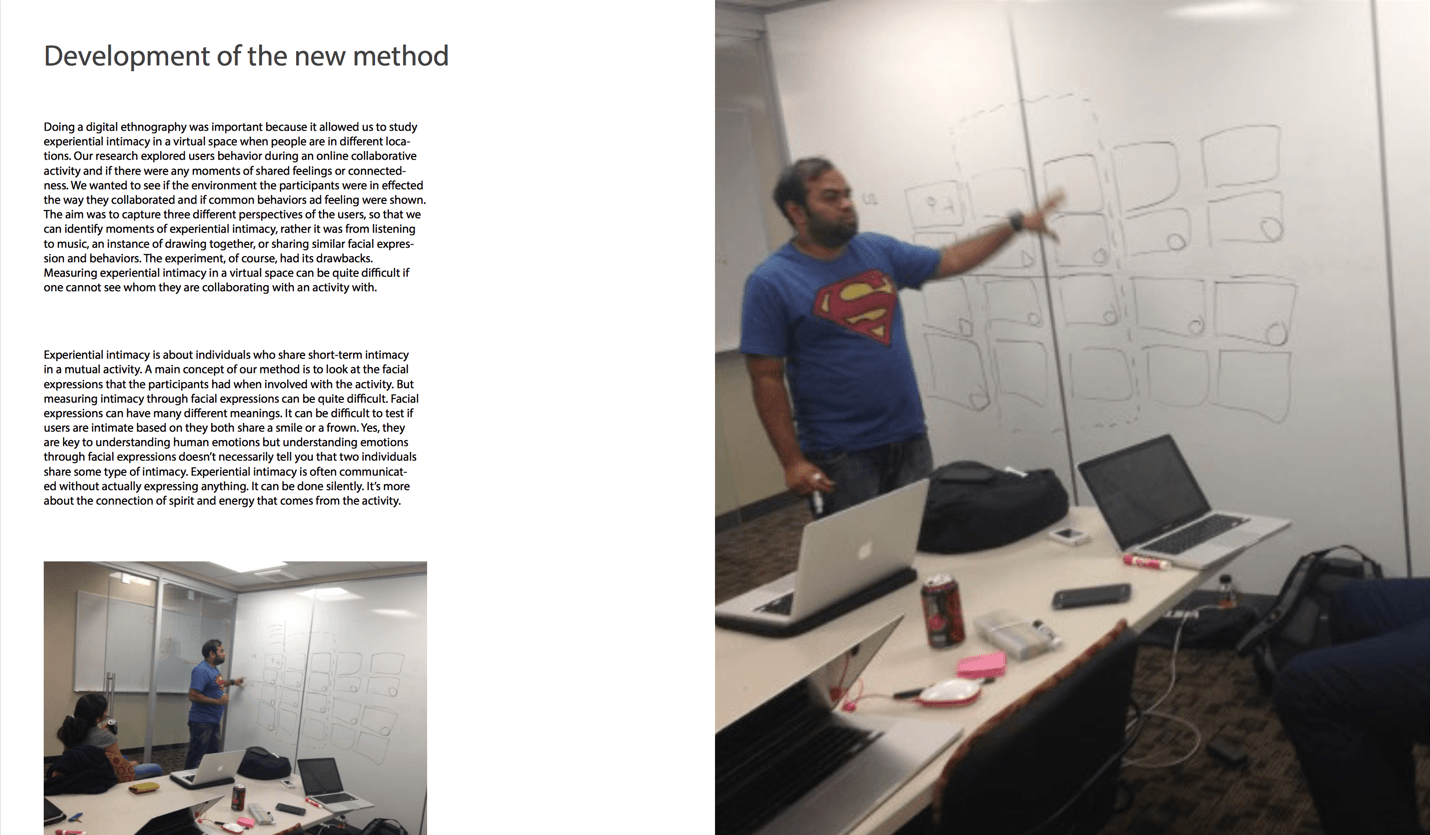
Slide title
4. Design Process
Button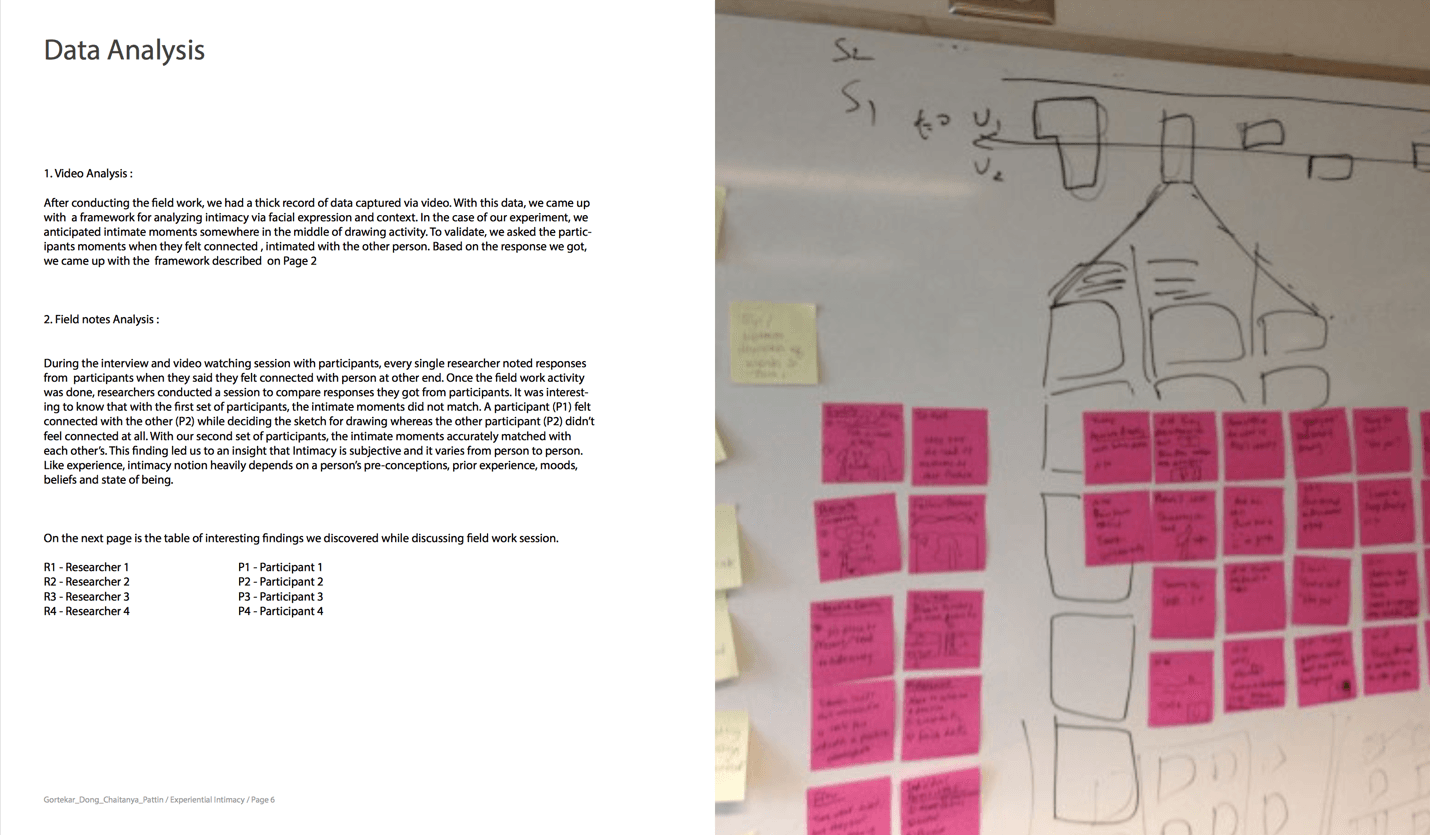
Slide title
5. Data Analysis
Button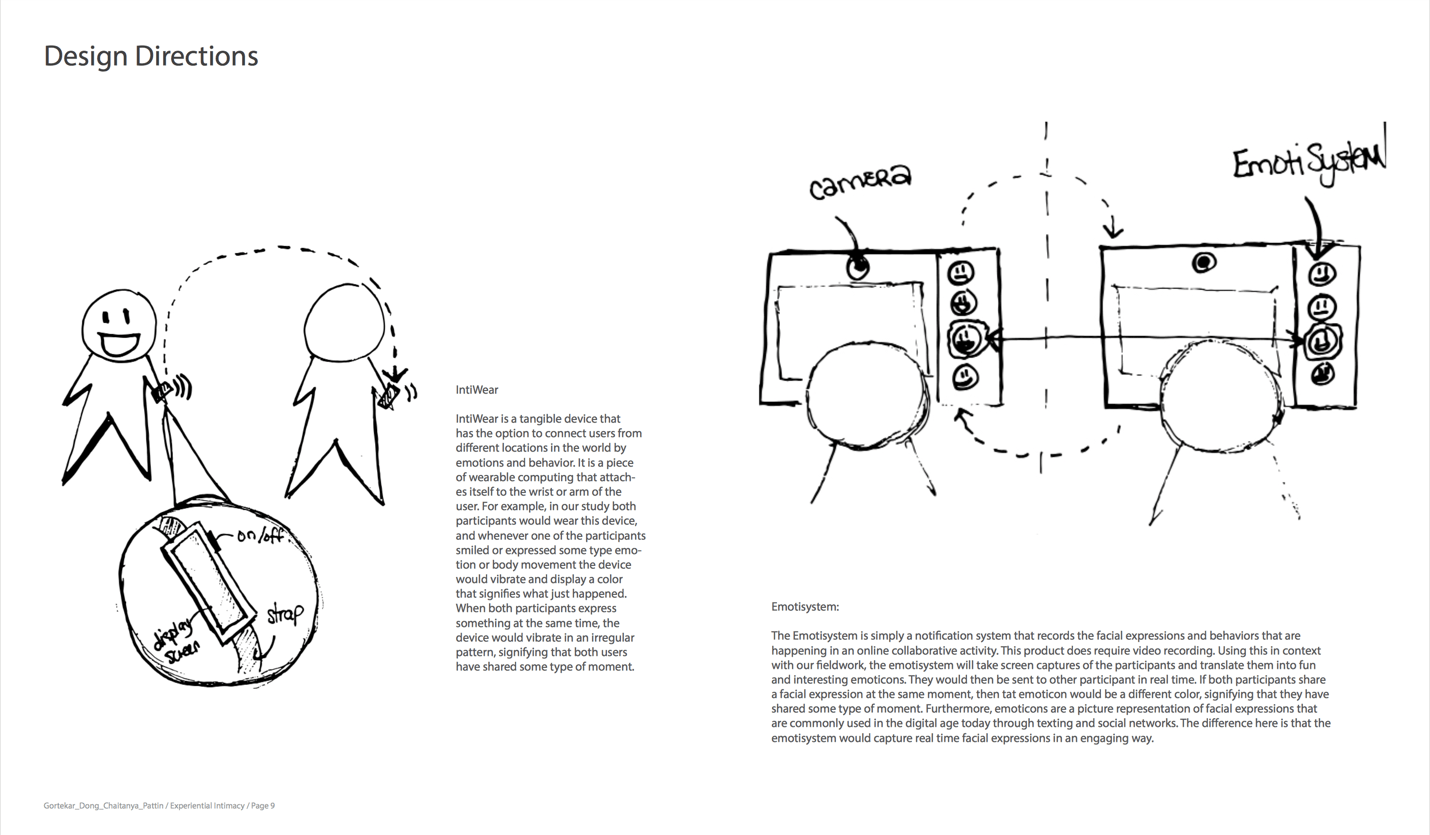
Slide title
6. Concept Sketching
Button
Description
Digital Ethnography is an adapted ethnographic method that aims to knit digital contextual data with physical contextual data together to capture a bigger picture of user’s action and their emotions with the help of a first person perspective screening and a third person perspective video recording.This method allows you to collect data with layered distance from your user, giving you a different perspectives on the activity.
Context
This method works best to help researcher understand user’s reaction to a digital product. What are the context of using this product?
Methods Pairing
It is best paired with interviews.
Assignment Refelctions
This being a newly developed method, it was hard to evaluate. Experiential intimacy is a type of intimacy that many are not aware of. It is very difficult to measure as it consists mostly of qualitative measurement. Capturing three different perspectives and mapping them according to time was interesting. We were able to identify common behaviors and feelings among subjects but at the same time, it was very hard to analyze the thick record of the data. Also, the method depends a lot on individual subject. Sometimes they are expressive other times they are not. So it is difficult to solely depend on facial analysis.
Image Based Research
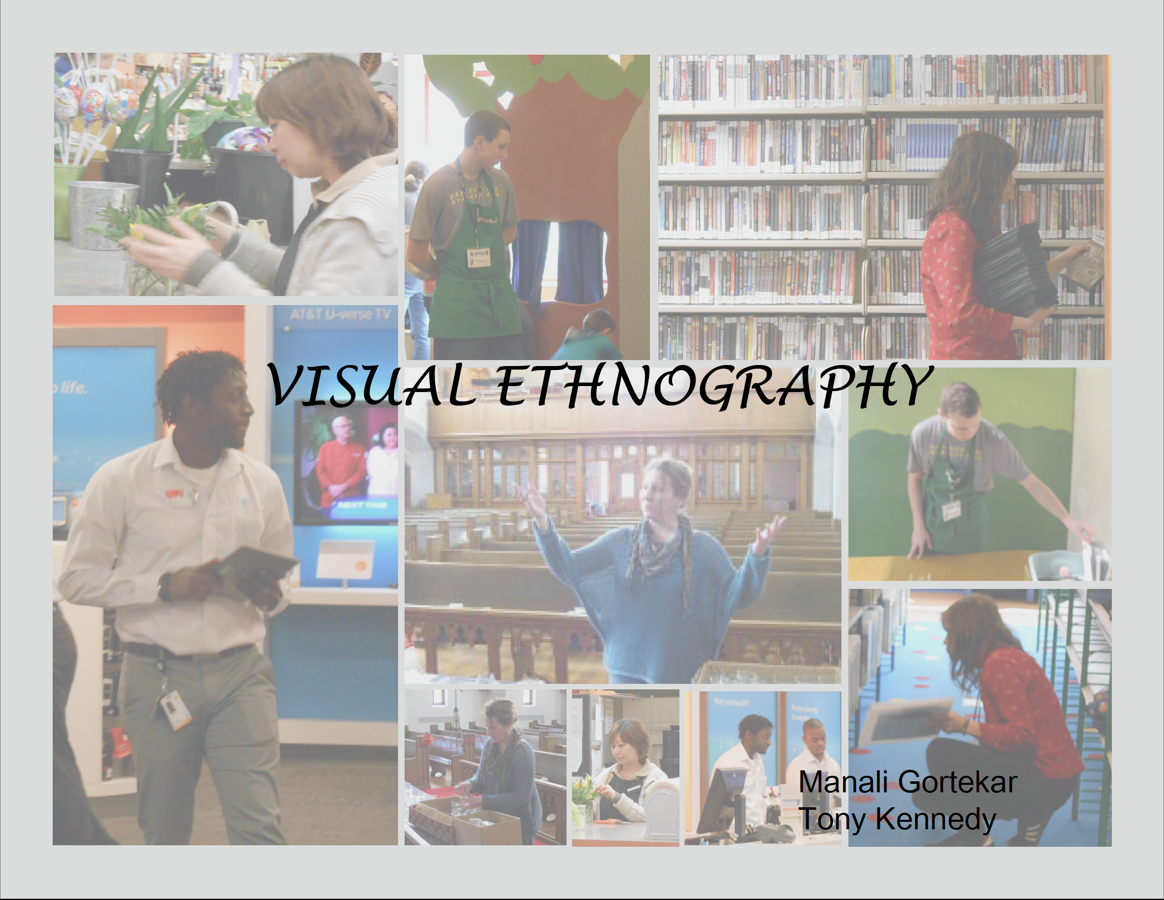
Slide title
1. Visual Ethnography Prompt
Button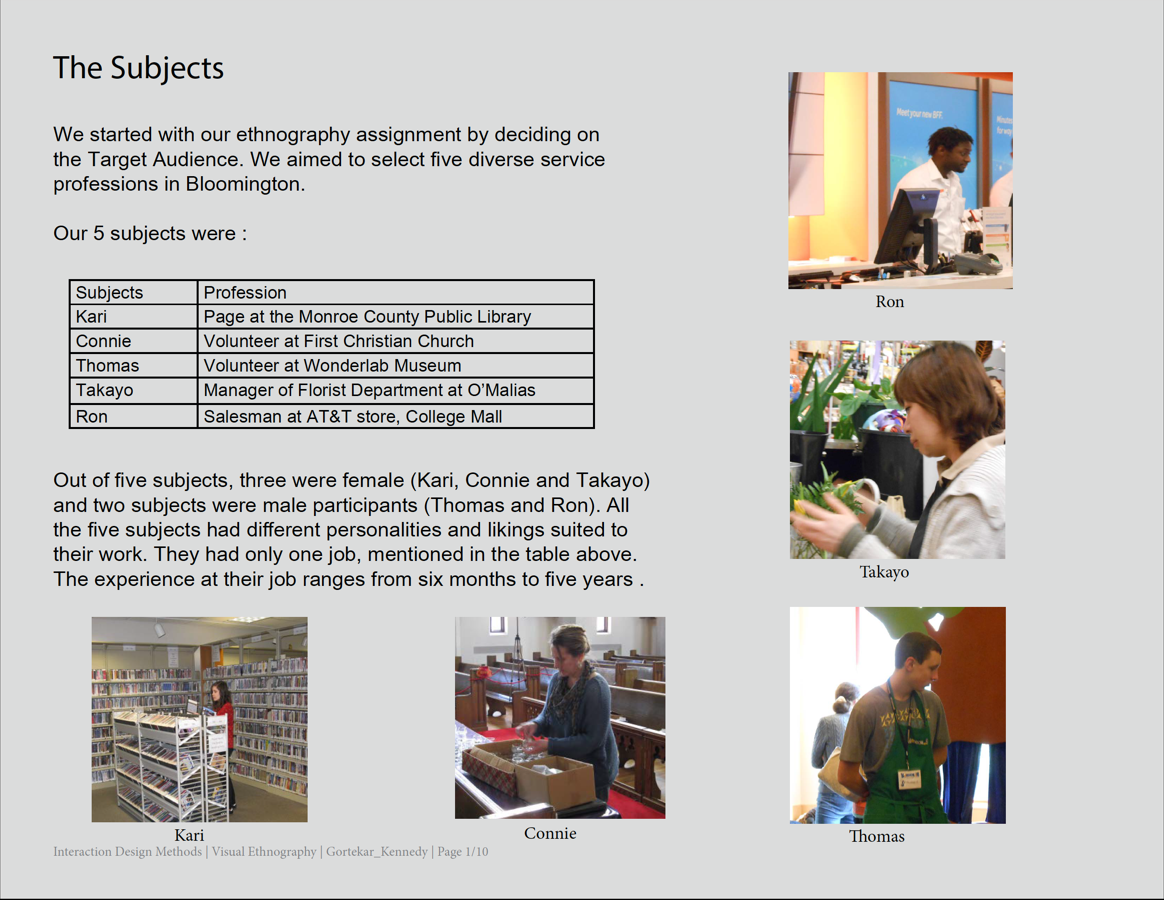
Slide title
2. Subjects
Button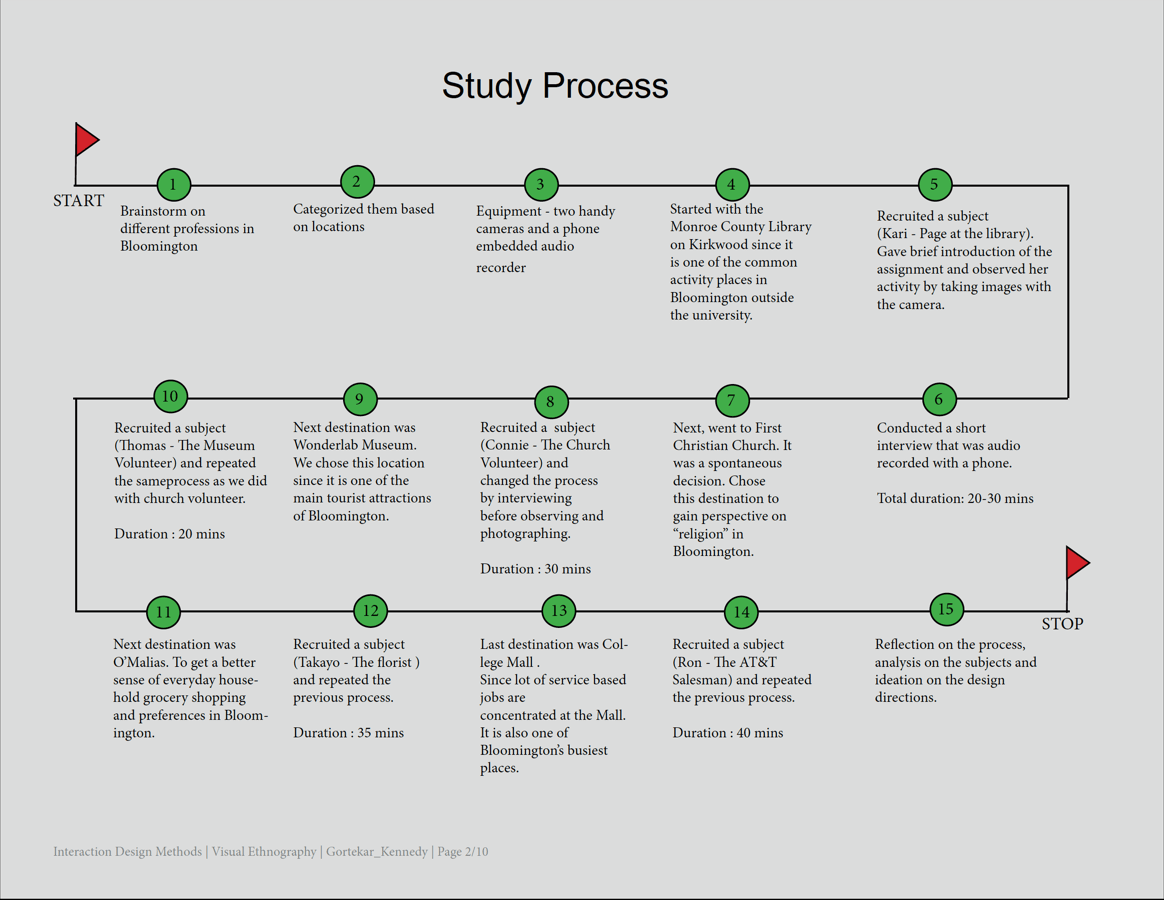
Slide title
3. Process
Button
Slide title
4. Subject Analysis
Button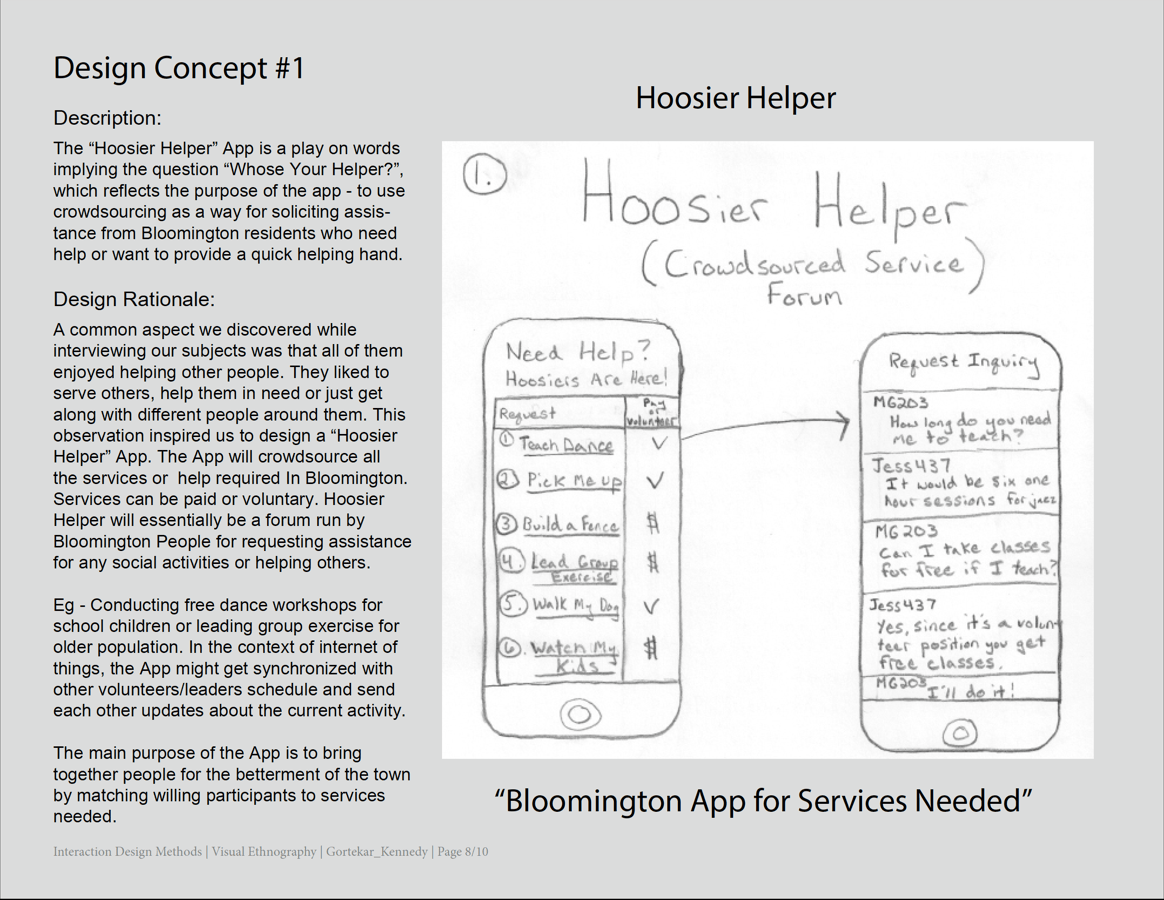
Slide title
5. Concept Sketching
Button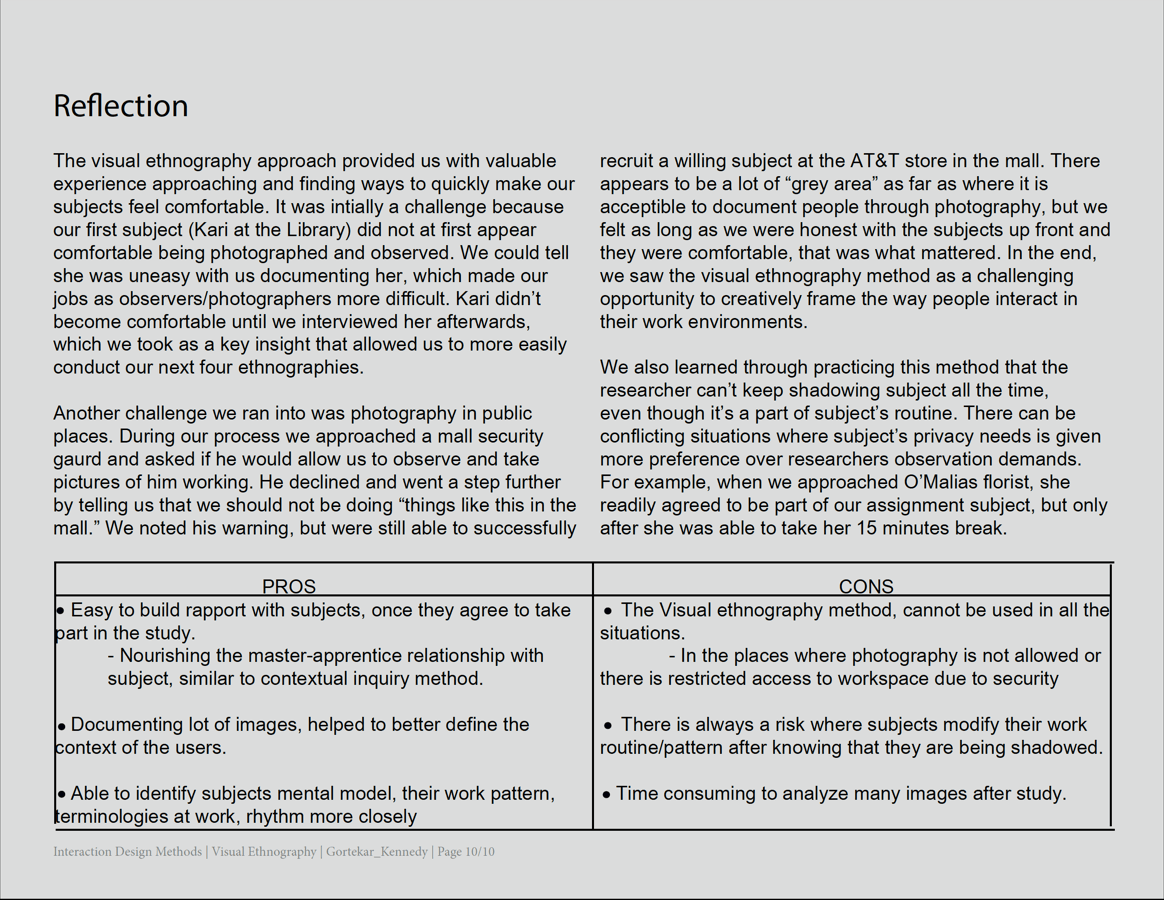
Slide title
6. Reflection
Button
Description
Image based research or Photo ethnography method is an effective way to document the user’s work portrait.
Context
Useful in a situation where a researcher wants to capture the “bigger picture” of the subject’s workplace. Pictures effectively conveys the ambiance, cluttering of a space which is hard to describe in words.
Methods Pairing
It is best paired with contextual inquiry where master-apprentice relationship is maintained.
Assignment Refelctions
Image based research method is effective in terms of capturing the context. Images triggers the memories of research conducted. A single image has a potential to convey thousands of words. Thus, image capturing is very efficient when researchers have lesser time to jot down the field notes. One of the limitations is that it is not a standalone method. It needs to be paired with interview and observation to make more sense of the context. This method is good for documentation purposes. It is important to ask for permission before taking the images from the user.
Personal Inventories
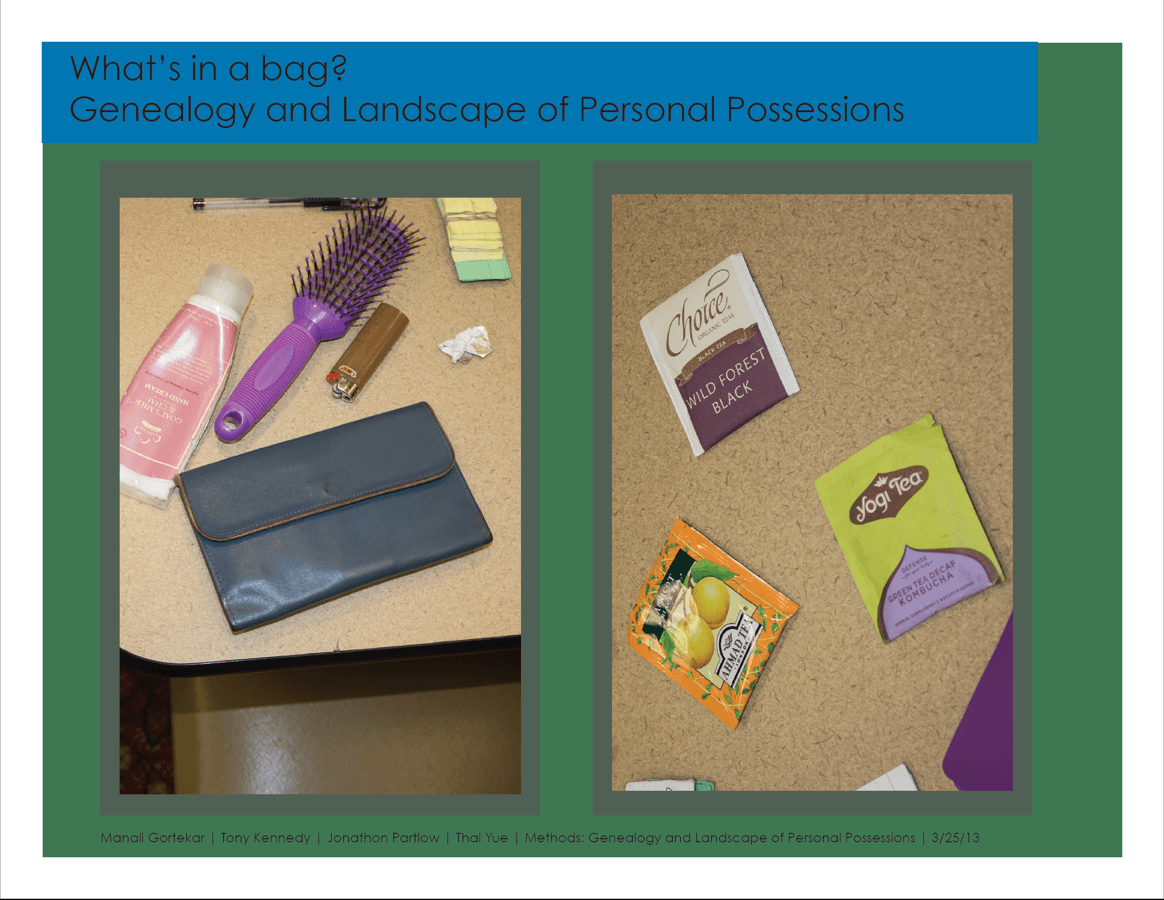
Slide title
1. Personal Inventories Prompt
Button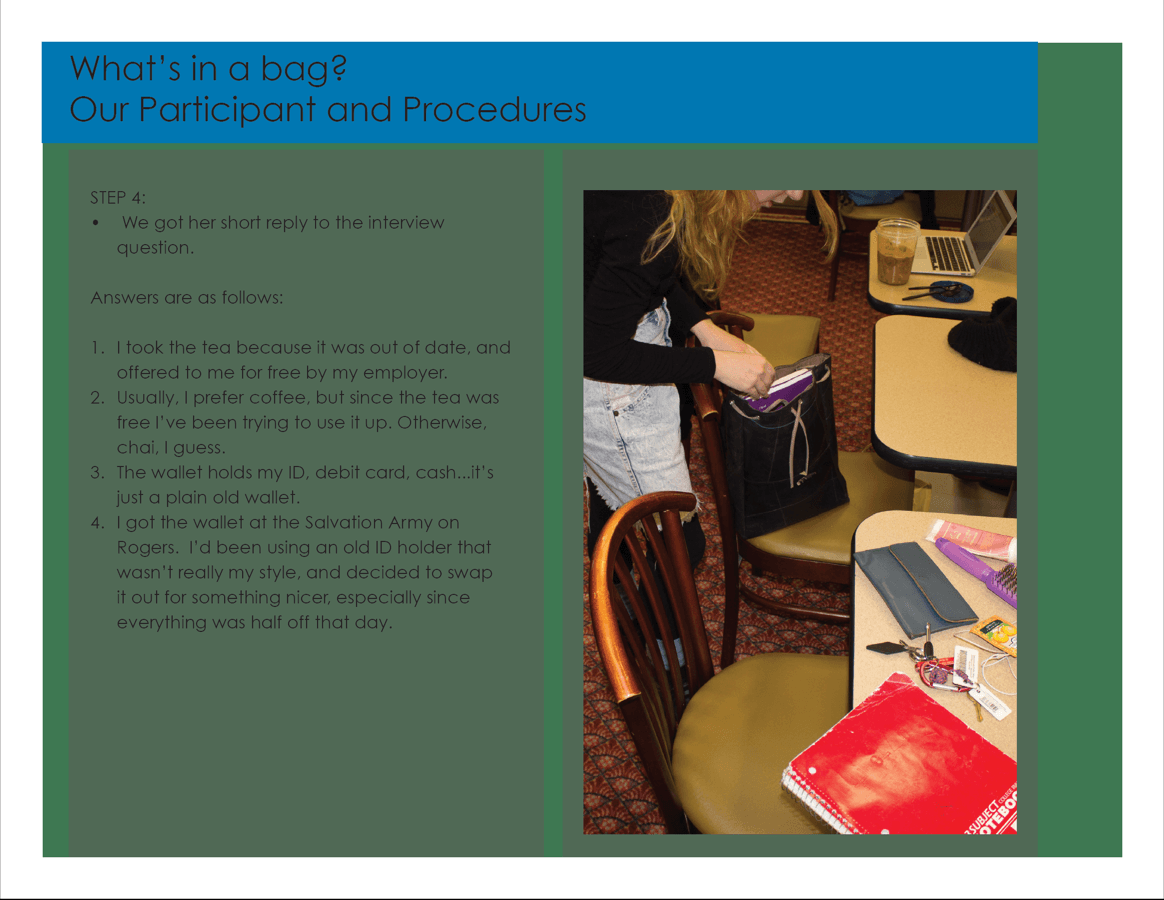
Slide title
2. Participant and Procedure
Button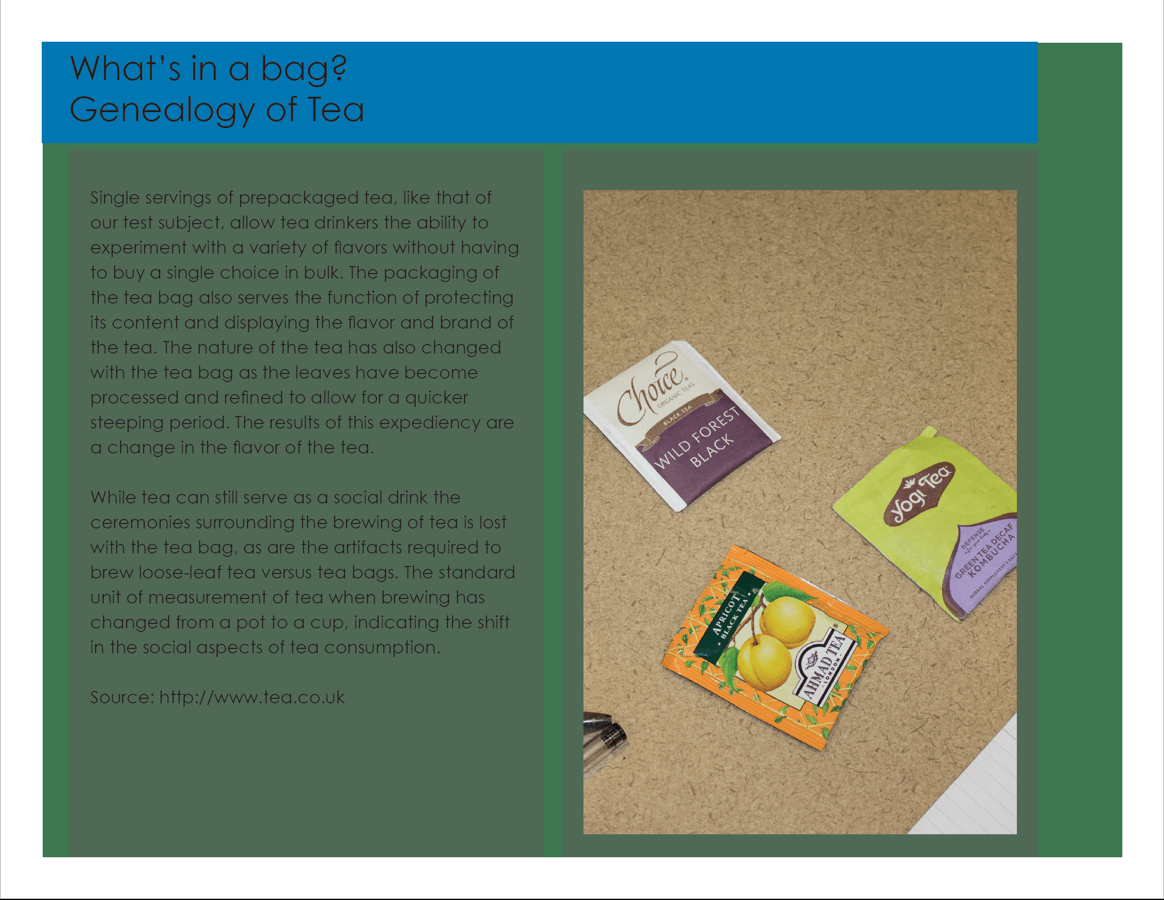
Slide title
3. Genealogy of Tea
Button
Slide title
4. Landscape of Tea
Button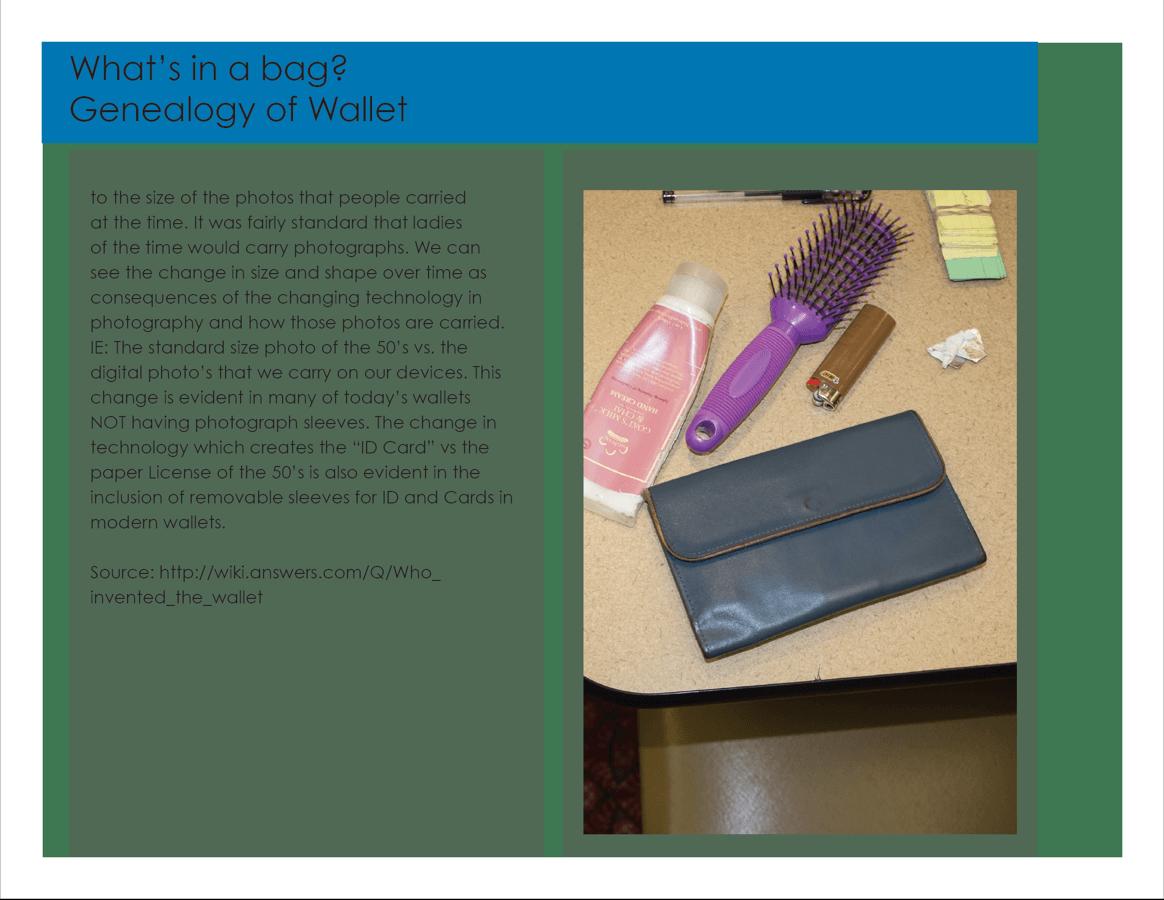
Slide title
5. Genealogy of Wallet
Button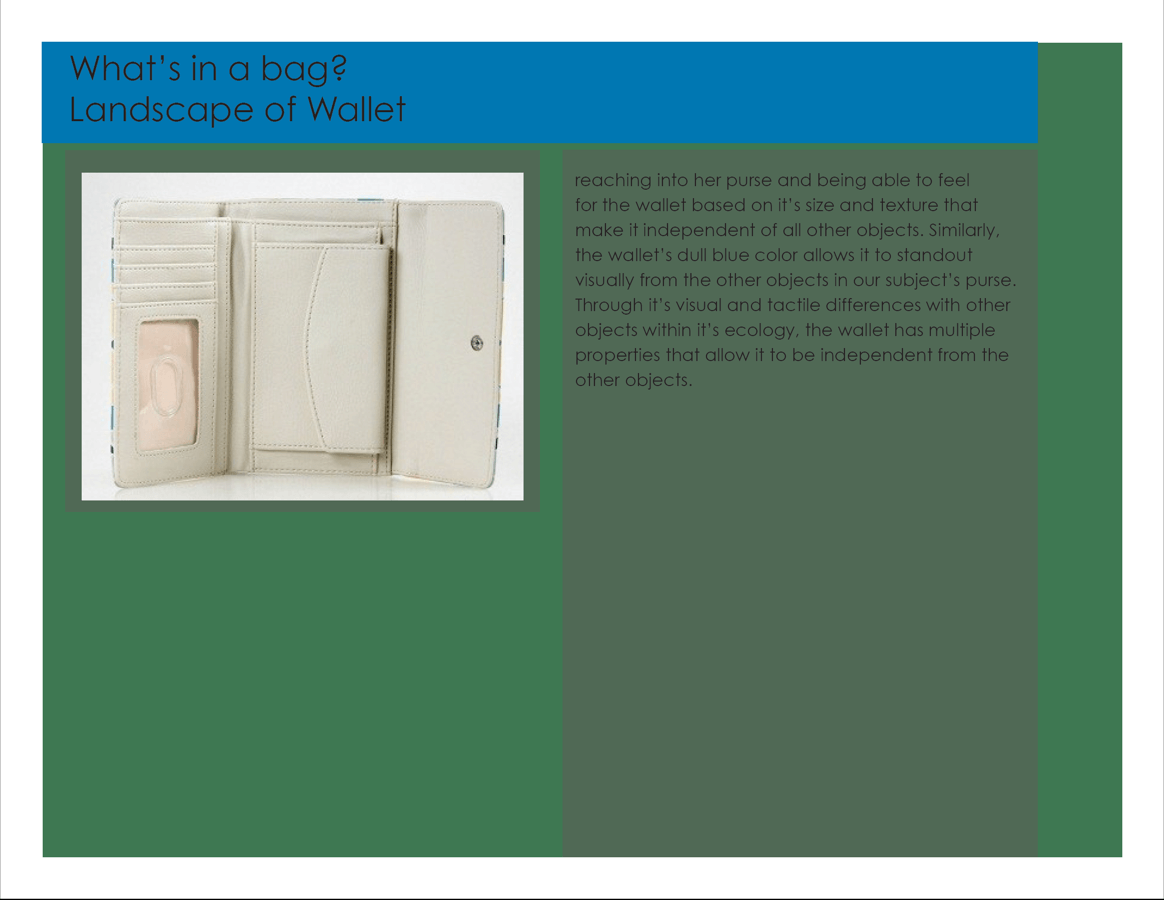
Slide title
6. Landscape of Wallet
Button
Description
Derivation of artifact analysis. It helps in knowing the breadth (landscape) and depth (genealogy) of an artifact in its ecology. The Landscape analysis is the horizontal view of an artifact where a researcher analyzes all the artifacts within the given material ecology. Genealogy is the vertical view of an artifact where a researcher looks into the history of one artifact and traces its emergence, development and transformations which all took part into turning the artifact into what it is.
Context
Useful in early stages of design process for getting that “inspiration”. Provocative objects either confirm our assumptions or rule them out.
Methods Pairing
The method is best paired with semi-structured interview to validate understanding of the Probe response.
Assignment Refelctions
Personal inventories are a good way to get a quick glimpse of user’s portable world. The different artifacts users keep with themselves informs researchers about their habits. Researcher is required to dig deep into artifact’s history. Landscape analysis was more useful in knowing relations an artifact has with others. It gives insights on how user uses an artifact with others. Identifying patterns in landscape analysis led to strong design directions. It is a good tool to learn about material ecosystem. I felt a slight disconnect between genealogy and landscape analysis of an artifact. It would have been interesting to see the design implications combining both the analysis.
Cultural Probe
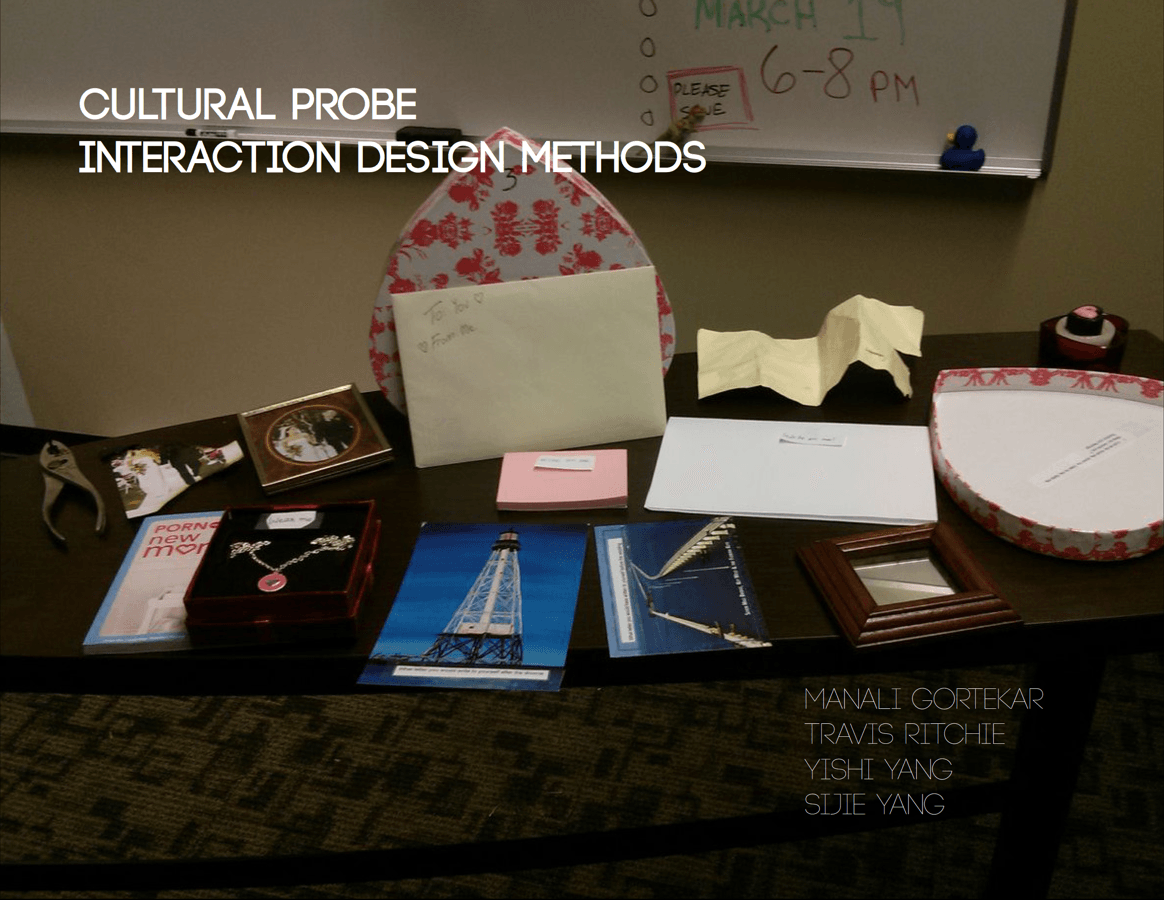
Slide title
1. Cultural Probe Prompt
Button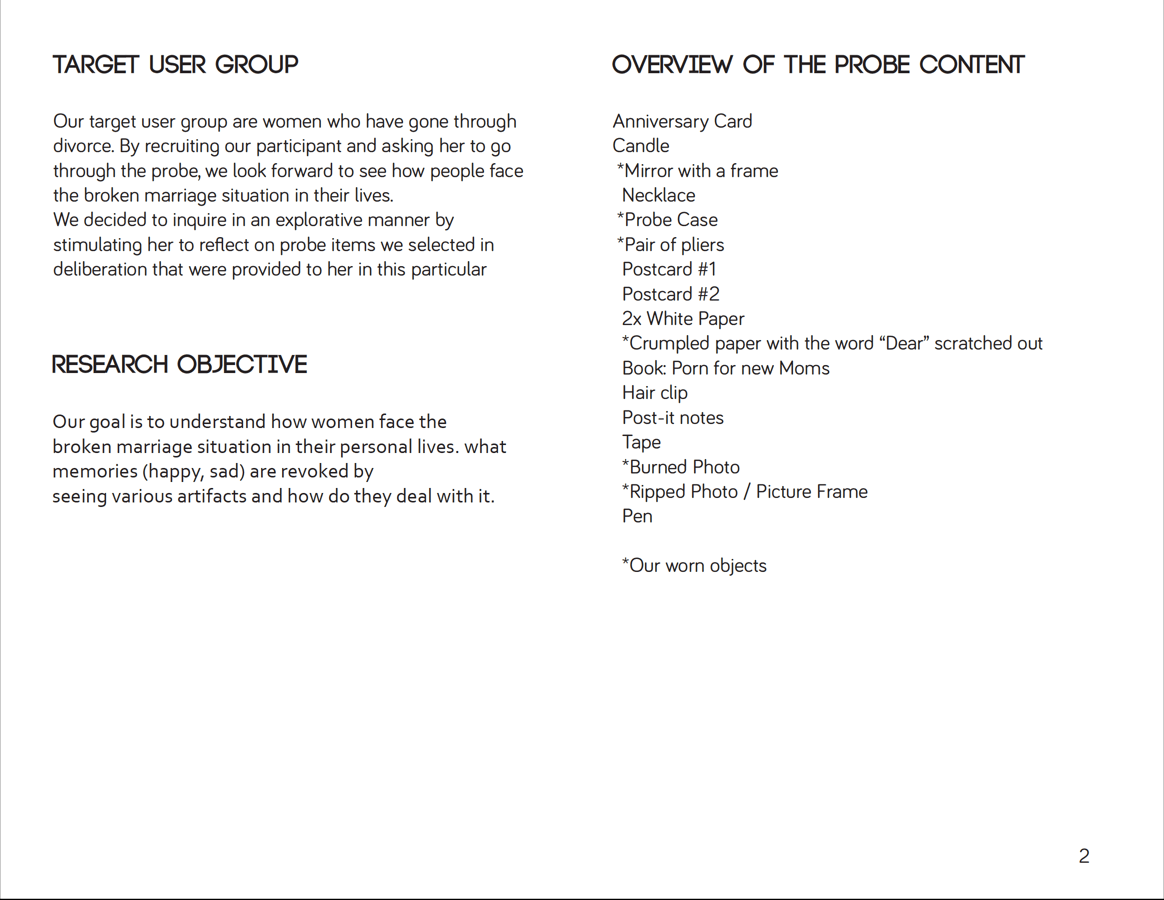
Slide title
2. User Group
Button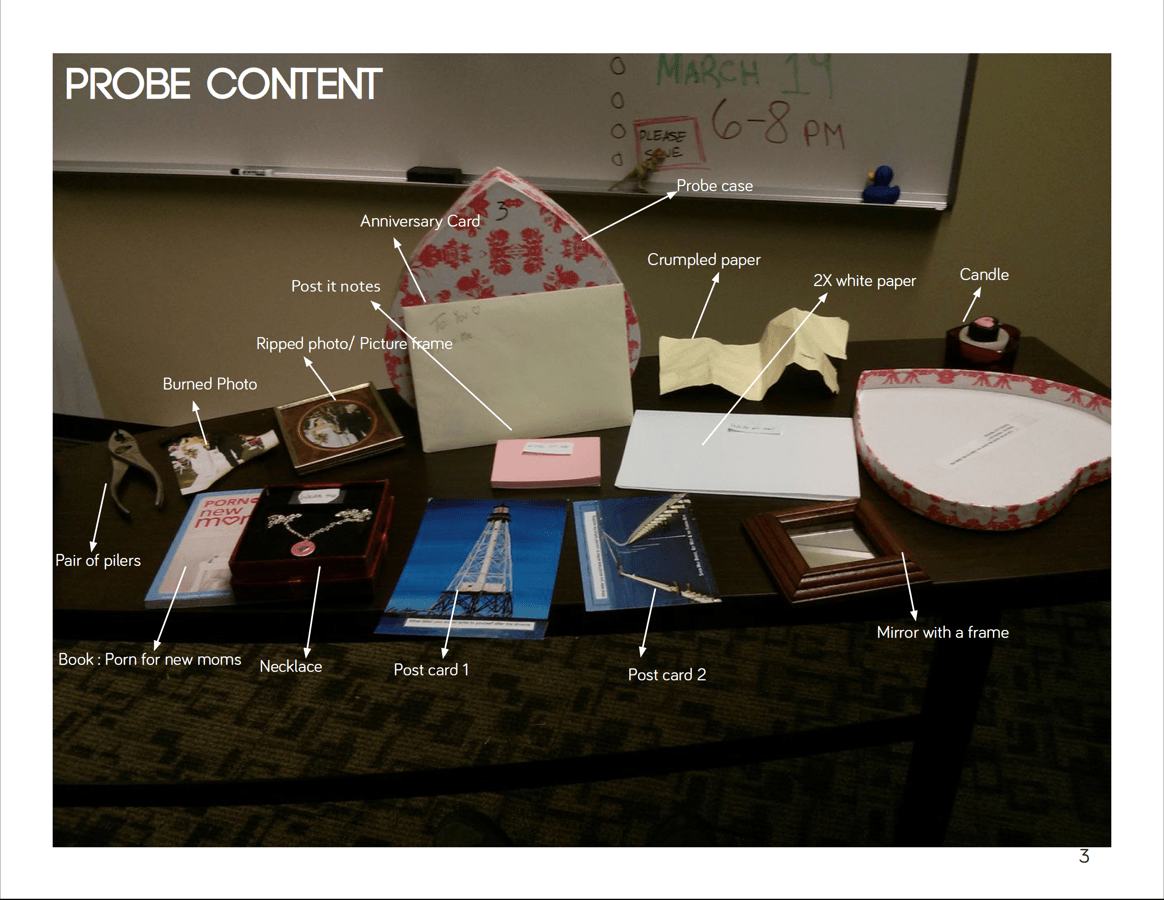
Slide title
3. Probe Items
Button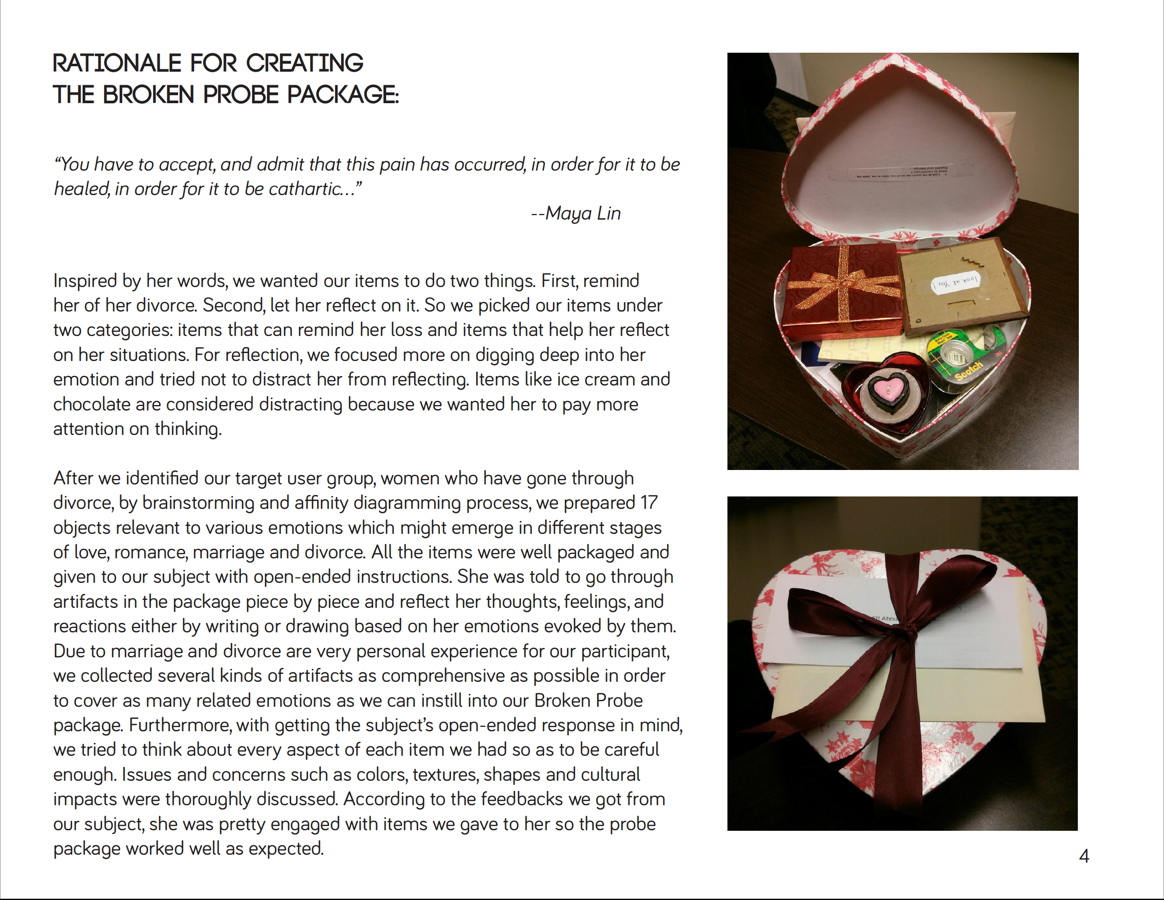
Slide title
4. Broken Probe
Button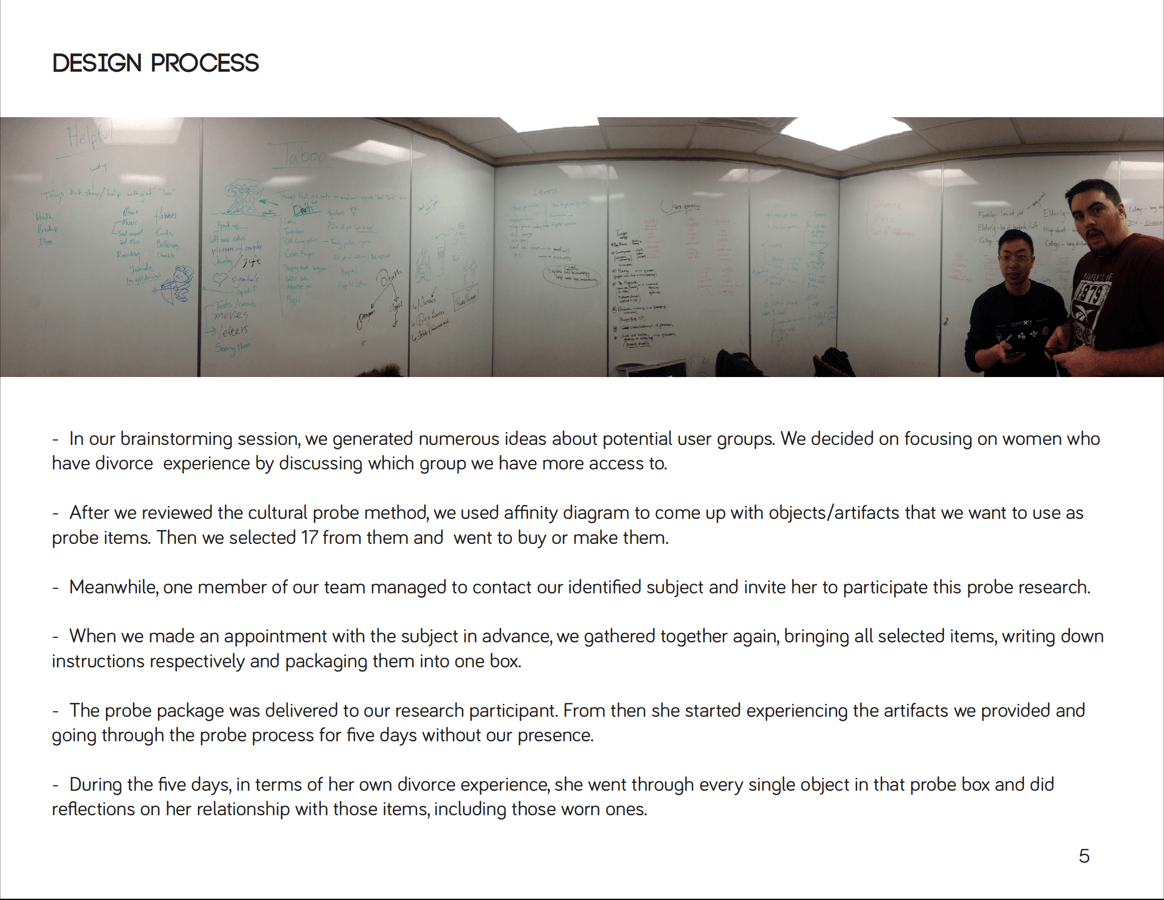
Slide title
5. Design Process
Button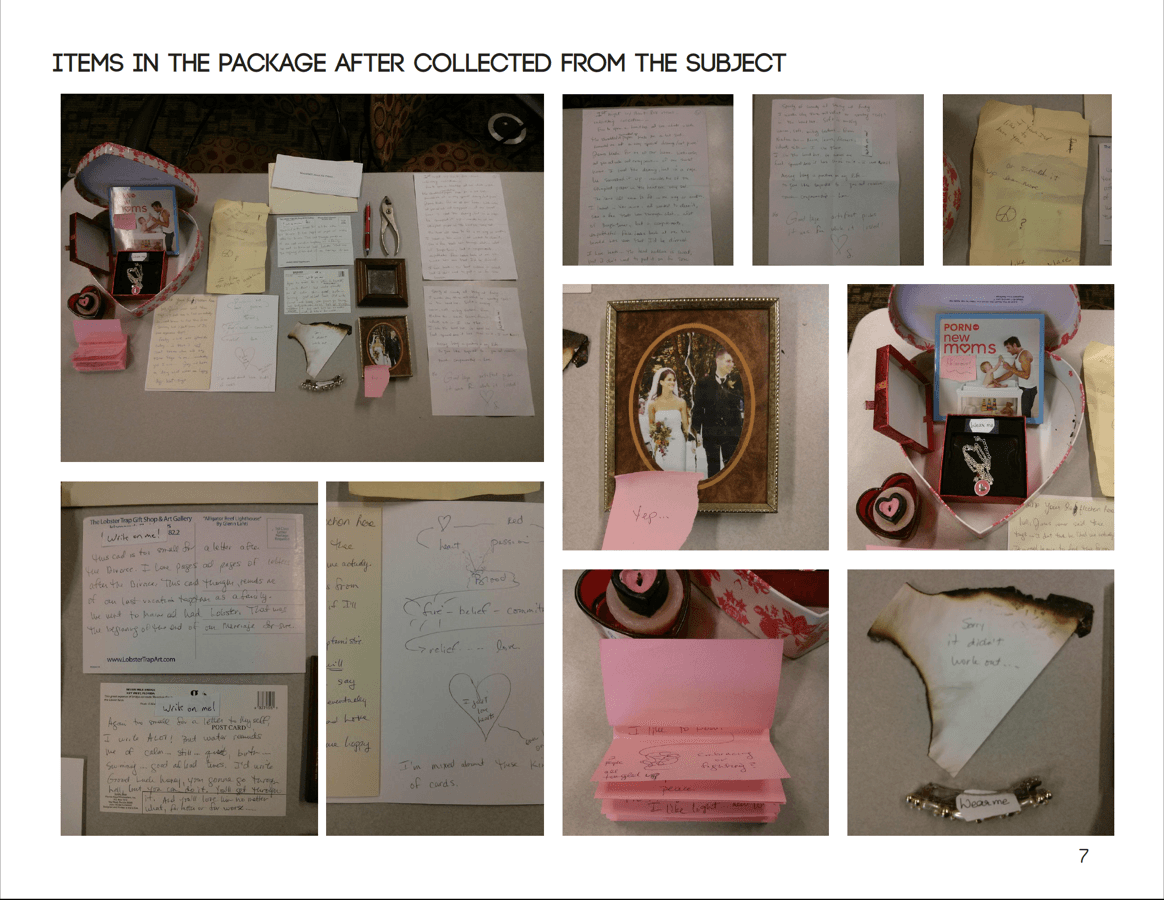
Slide title
6. Items collected after probe
Button
Description
Cultural probe is open ended and is very effective in getting users perspective. It is a step ahead of ethnography study where researchers need not be on the fieldsite. The creators of cultural probes place the method in the artist-designer realm, with an emphasis on being openly subjective, collecting inspirational data to stimulate design imagination. Materials can be inspirational, ludic and provocative.
Context
Useful in early stages of design process for getting that “inspiration”. Provocative objects either confirm our assumptions or rule them out.
Methods Pairing
The method is best paired with semi-structured interview to validate understanding of the Probe response.
Assignment Refelctions
Cultural probe is a good way to validate researcher’s predispositions. It either confirms or rules out a researcher’s assumptions. Due to its open ended nature, it is difficult to predict the outcome of a cultural probe which, in turn, leads to interesting findings researcher may never have thought of. It is also a good tool to know different cultures researcher is not familiar with. It is best paired with observation and interview to gain insights on the context. The limitation of this method is that there is no direct relation between probe findings and design implications. The main intention of the probe is to find inspiration for the design which requires a highly skilled researcher to conduct it.
Artifact Analysis

Slide title
1. Artifacts Analysis Prompt
Button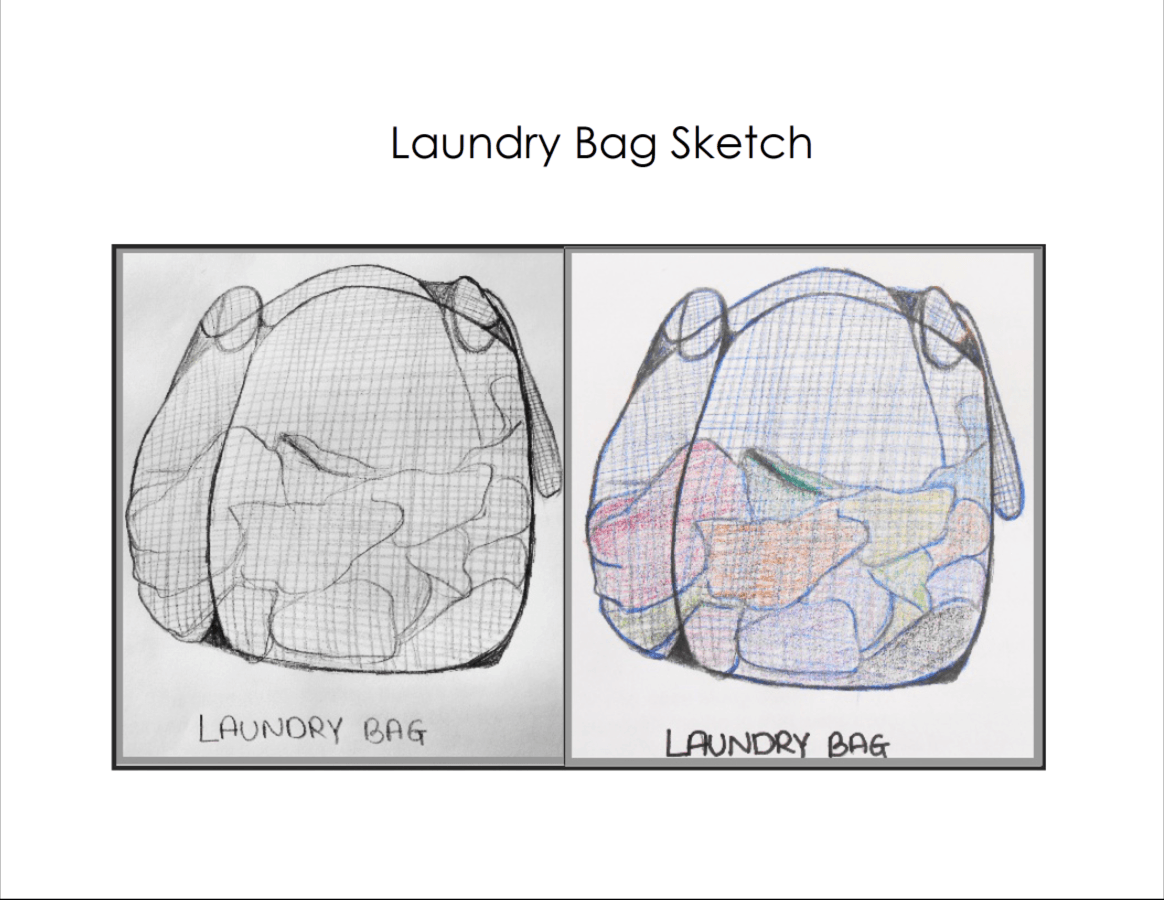
Slide title
2. Laundry Bag Sketch
Button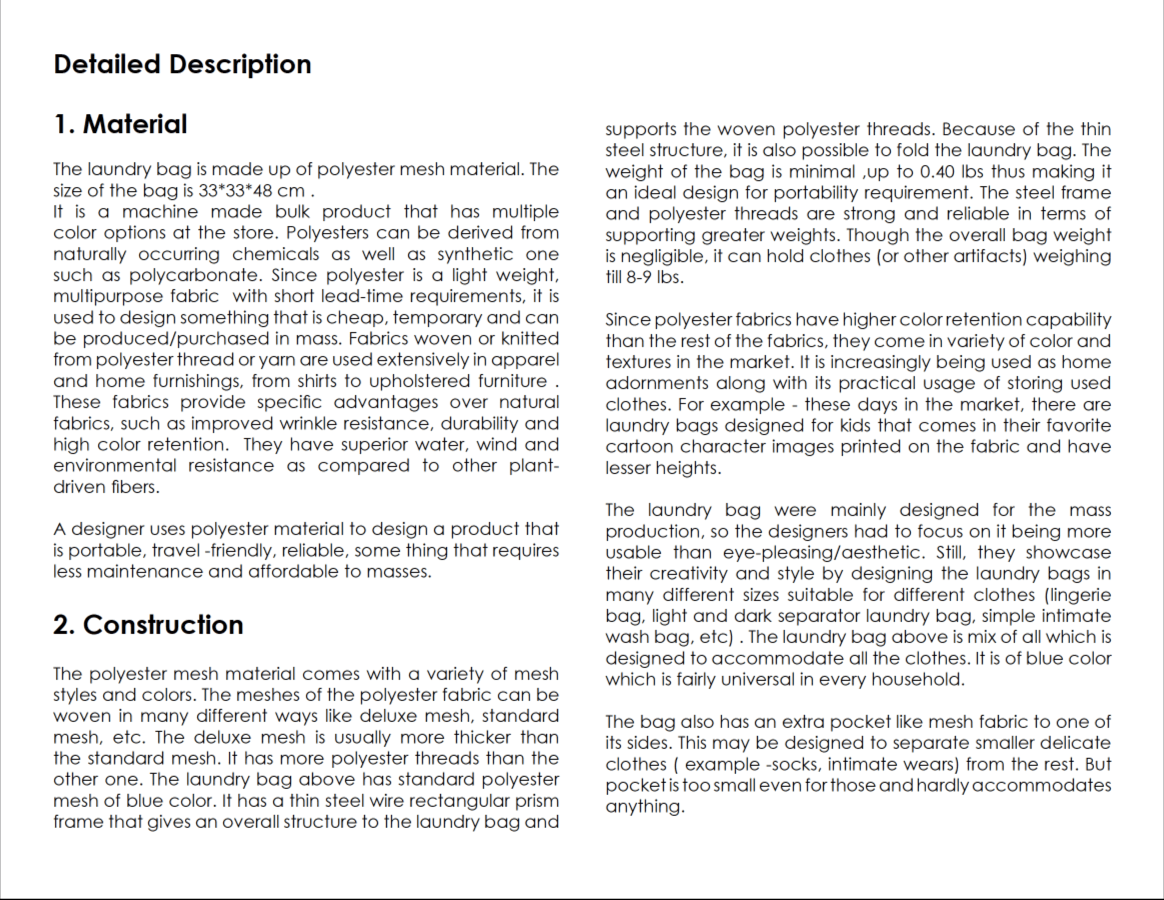
Slide title
3. Analysis
Button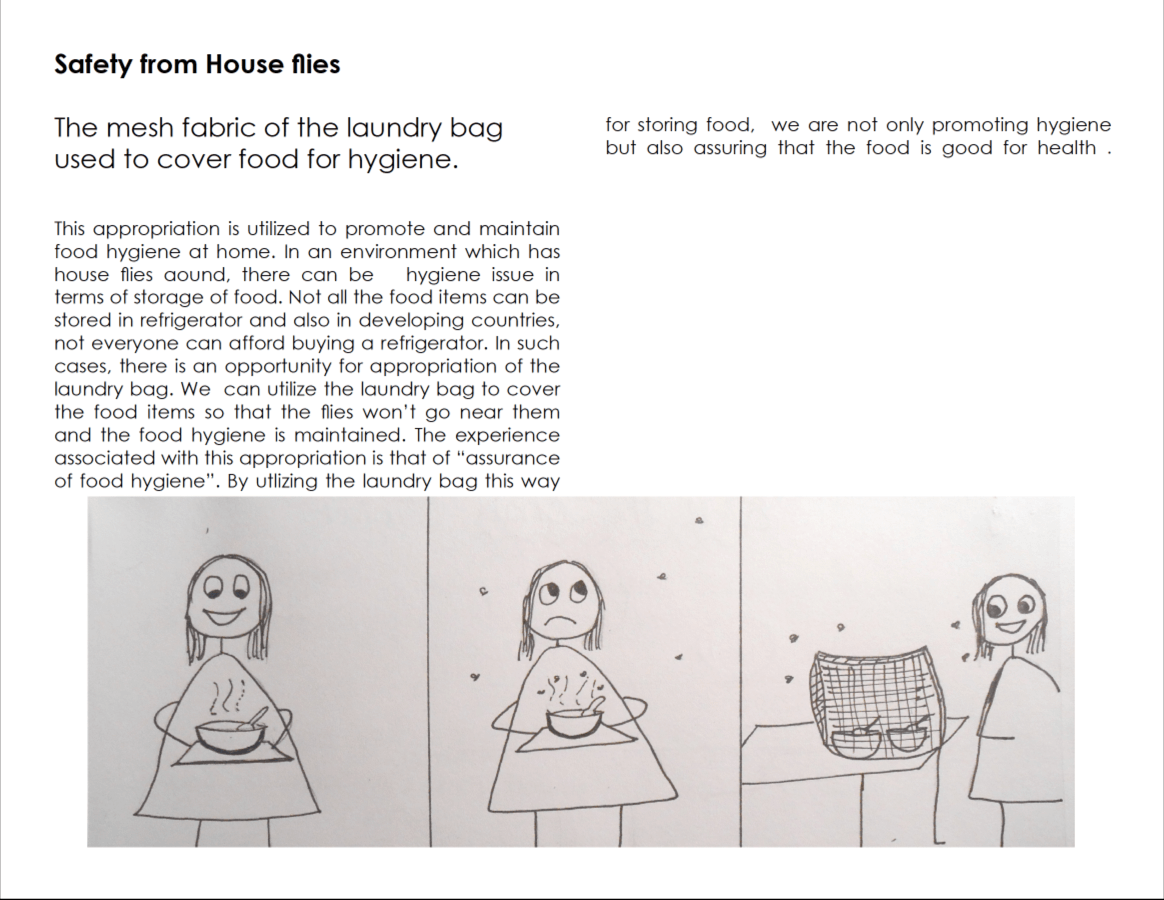
Slide title
4. Concept Sketch One
Button
Slide title
5. Concept Sketch Two
Button
Description
Artifact analysis is a thorough analysis of an artifact that leads to major design insights. Emphasis is placed on the extent to which an artifact participates in a system of artifacts and the possible interaction among artifacts. Artifact's material, its construction, function, provenance and value is specially taken into account.
Context
Useful in a situation when an artifact needs to be re-designed. Its thorough analysis, relationship with people, different usage leads to its defamilarization and new design directions.
Methods Pairing
This method can be paired with observation, interviews and personal inventory studies.
Assignment Refelctions
Artifact analysis is good tool to de-familiarize every day object. By distancing the object from its context, researchers can have interesting insights regarding the thought process that went behind object design, its evolution over a period of time and place in society. It is fascinating to observe the “personality quirks” of a mundane object and style given by its designer. This method is effective in thorough understanding of an artifact. There is an element of “ensoulment” to it which comes with a risk for researcher to get too much attached with the artifact to see any flaws. Researcher has to maintain critical stance for informing design directions of an artifact.
Diary Study
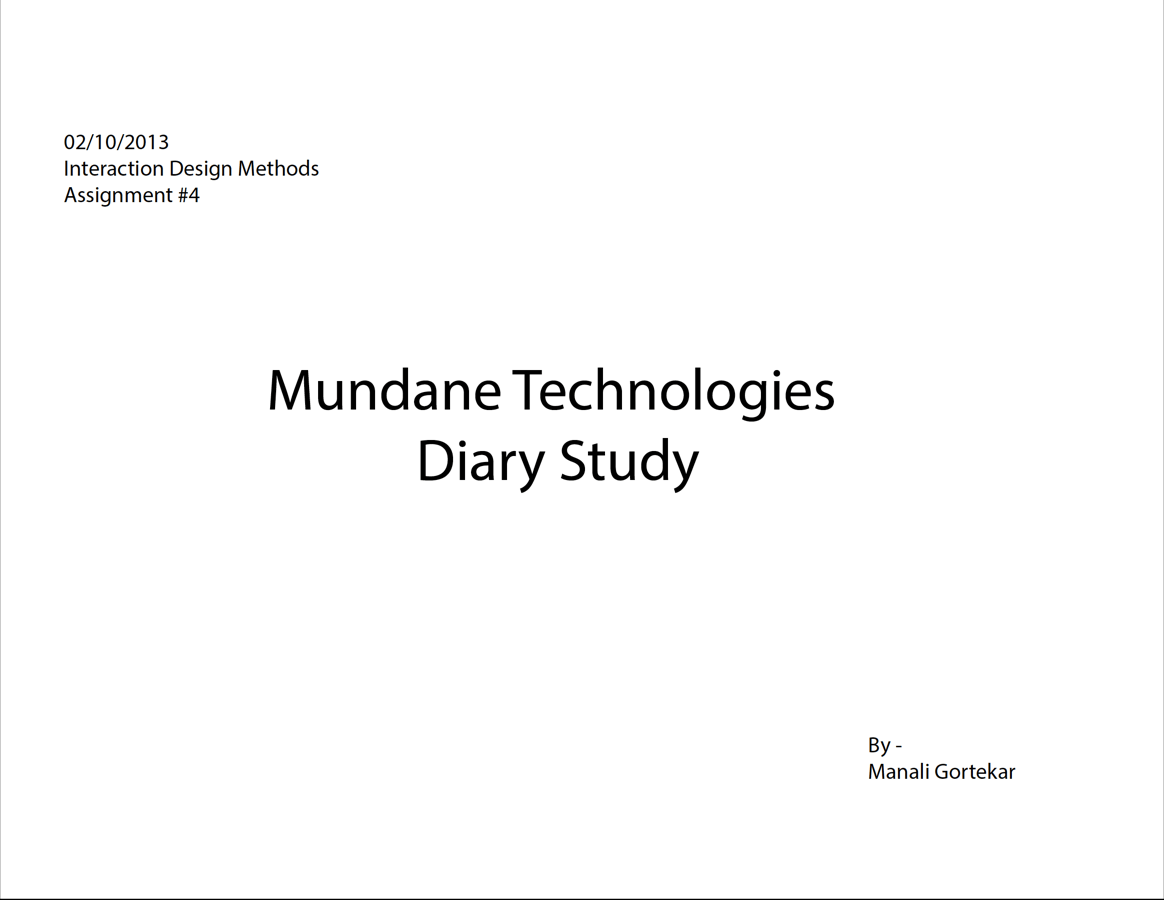
Slide title
1. Dairy Study Prompt
Button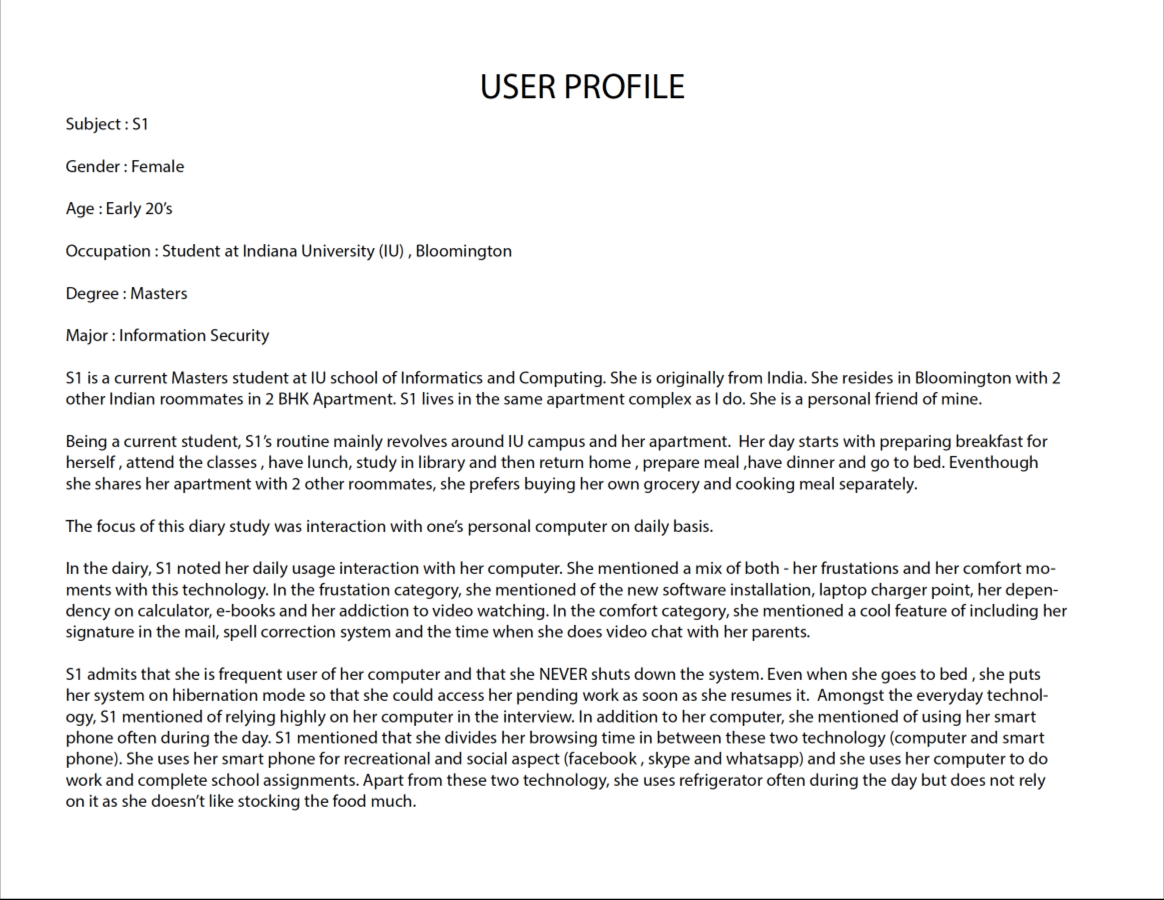
Slide title
2. Data Gathering
Button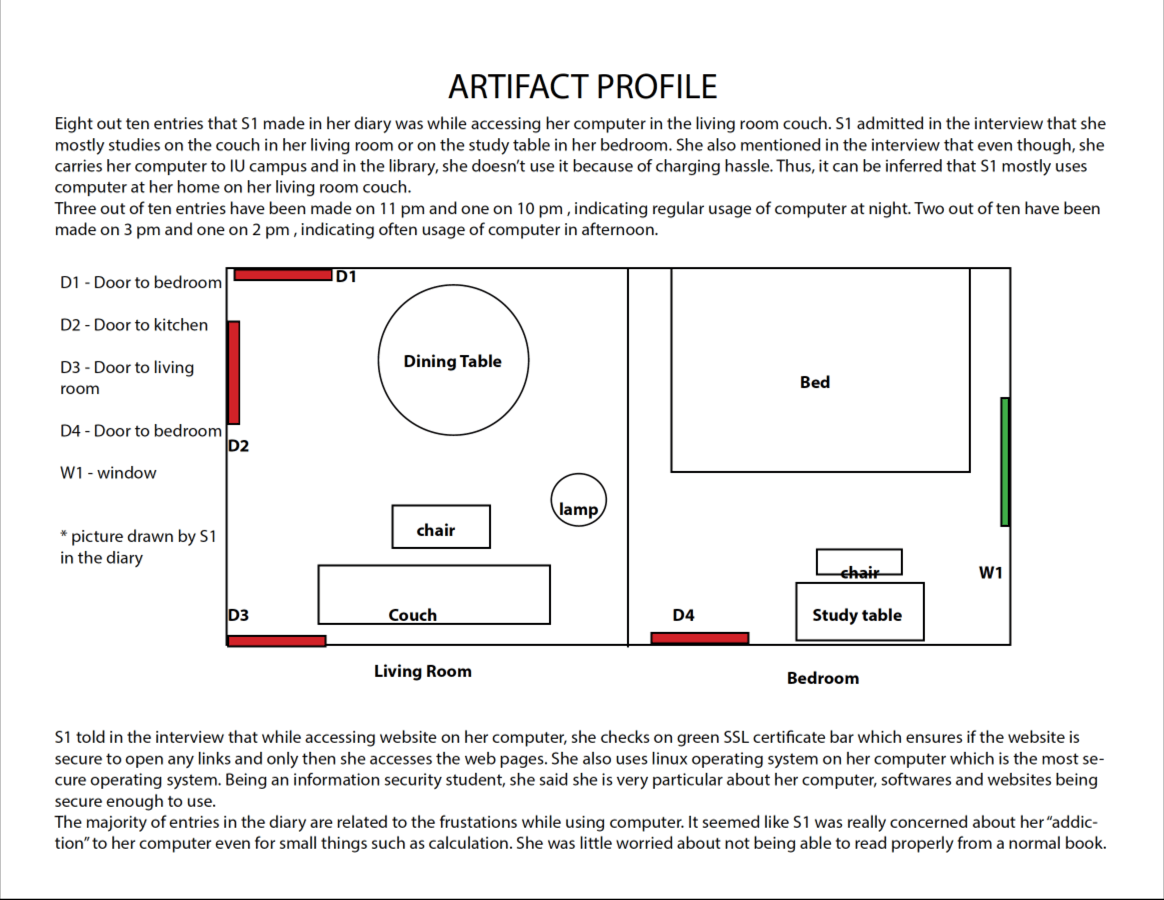
Slide title
3. Data Gathering
Button
Slide title
4. Analysis
Button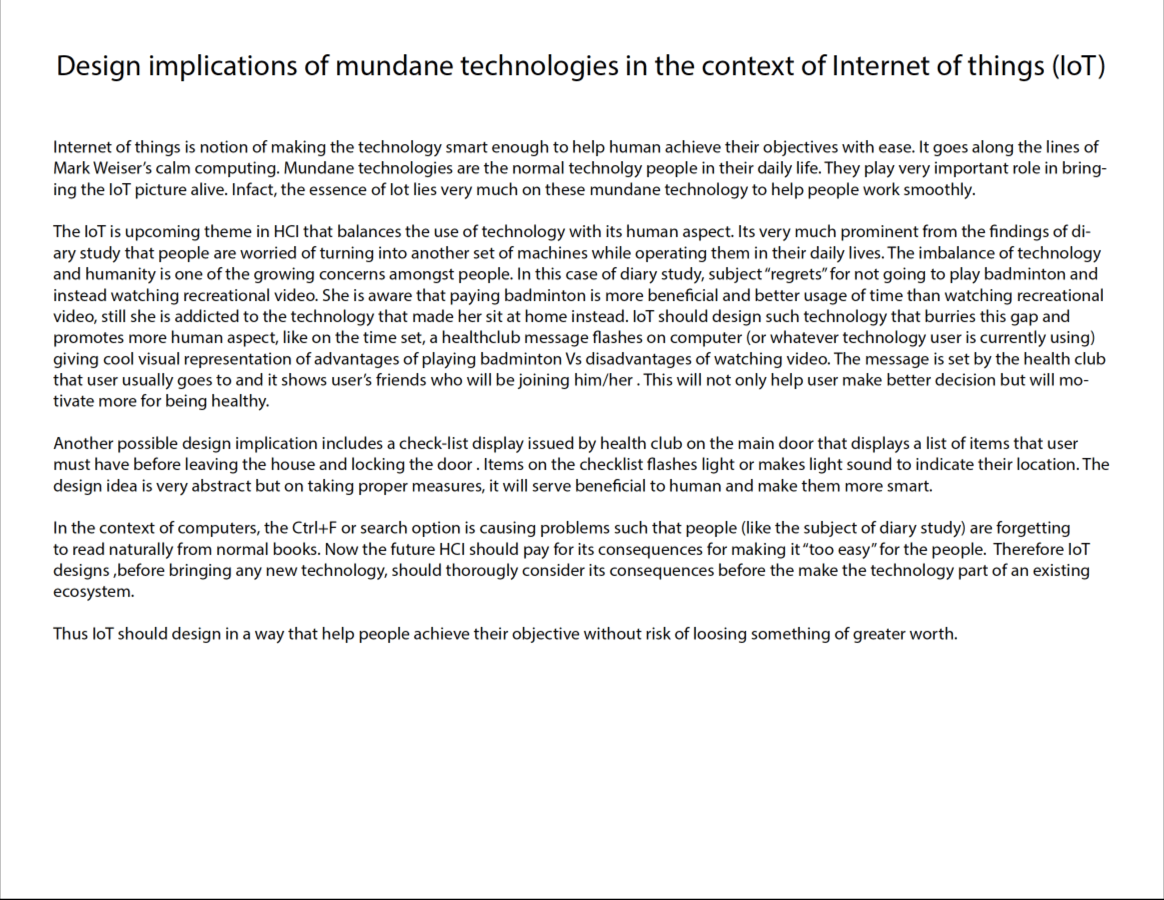
Slide title
5. Implication
Button
Description
Diaries are easy way to get a peep into users life, their routine, values, thoughts without being on the fieldsite. If it is quantitative data collection study, recruiters can be more. If it is a qualitative data collection study, recruiters should be less.
Context
Useful in a context when you want to study behavioral patterns of user in handling devices.
Methods Pairing
It is best paired with interviews.
Assignment Refelctions
Diary study was also effective in terms of understanding a single user. The ball was in user’s court which means users decide what to tell and how to tell their experience to the researcher. Having said that, researcher cannot entirely hold the user responsible for research results. Irrespective of the amount of efforts user puts in completing his/her diary, there is always a great deal of analysis that researcher could do. Pairing diary study with interview was very effective as it clarified the context in which users wrote/noted their experience. It has a single user dimension as opposed to several user dimensions of contextual inquiry.
Ethnography
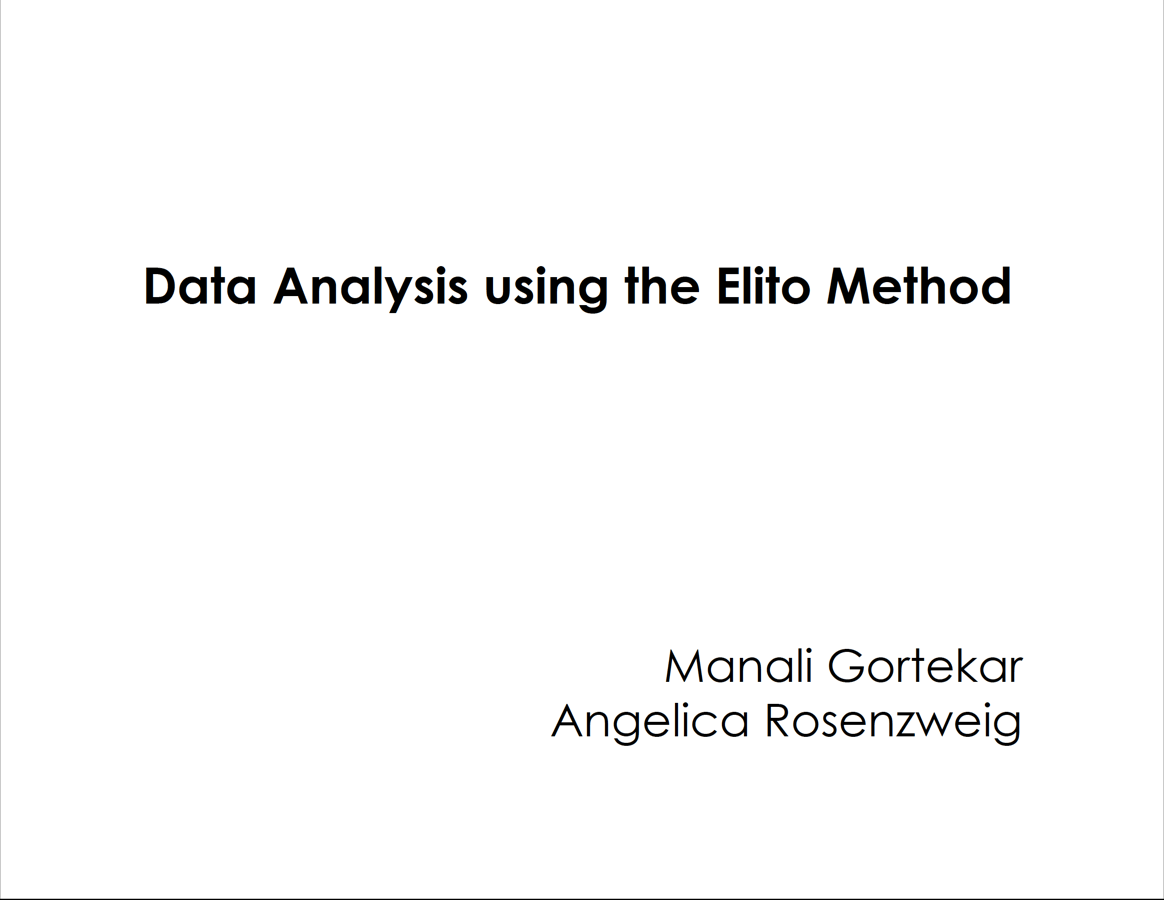
Slide title
1. Ethnography Data Analysis
Button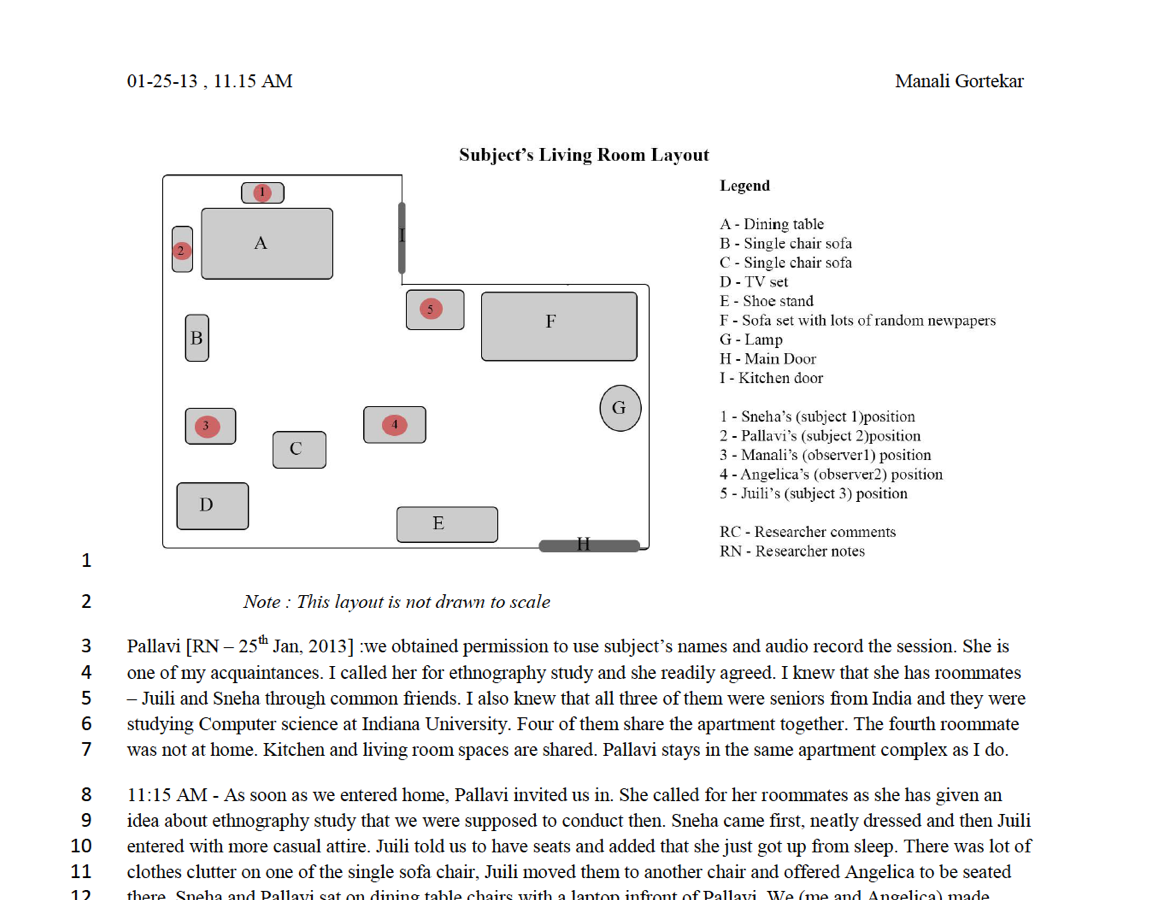
Slide title
2. Data Collection
Button
Slide title
3. Analysis by Elito Method
Button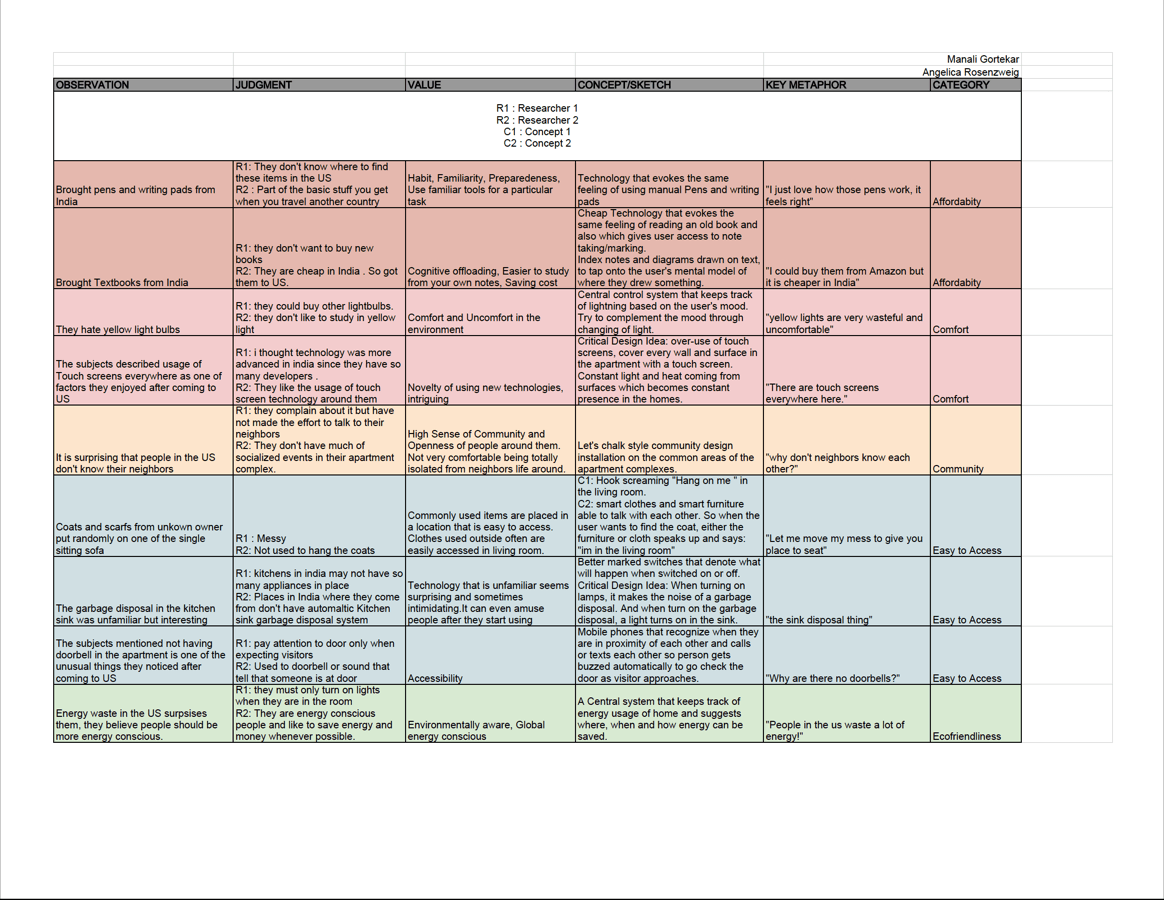
Slide title
4. Spreadsheet
Button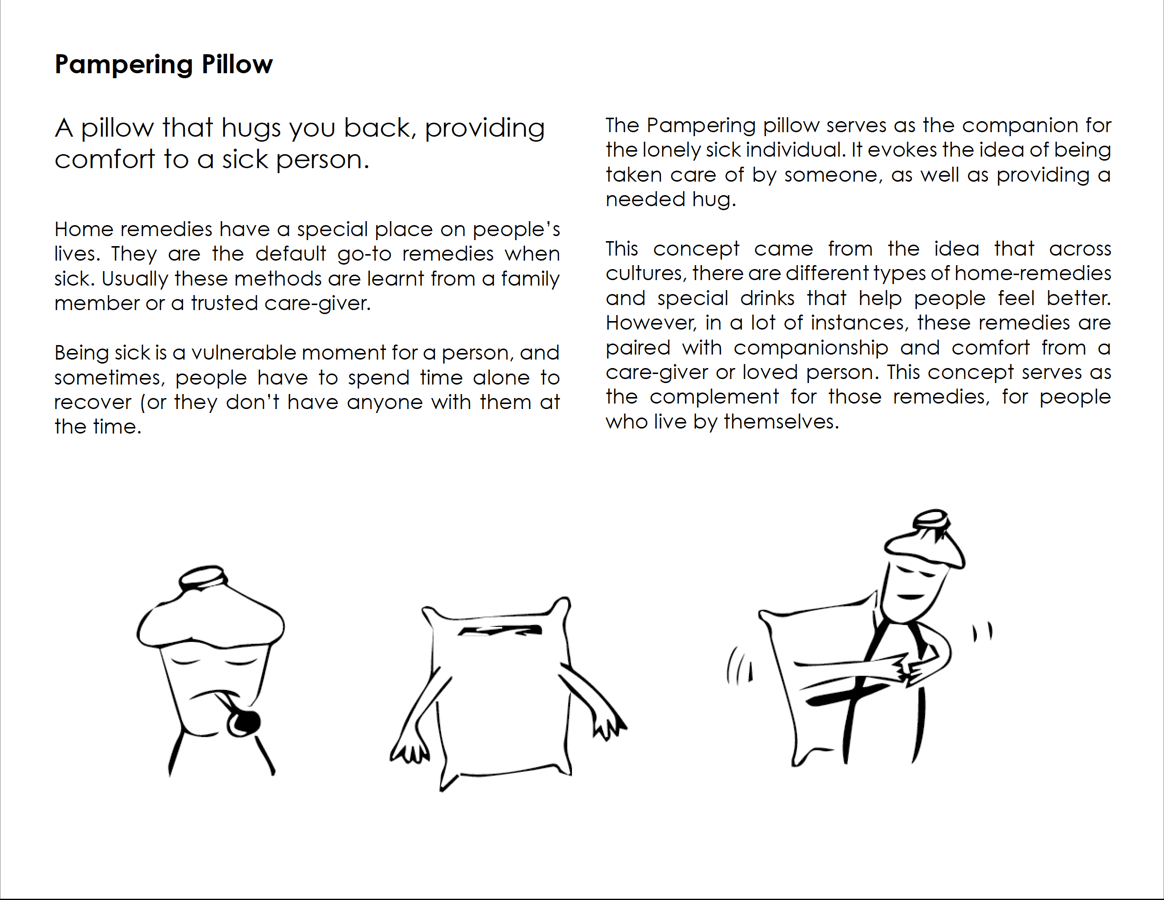
Slide title
5. Concept Sketching
Button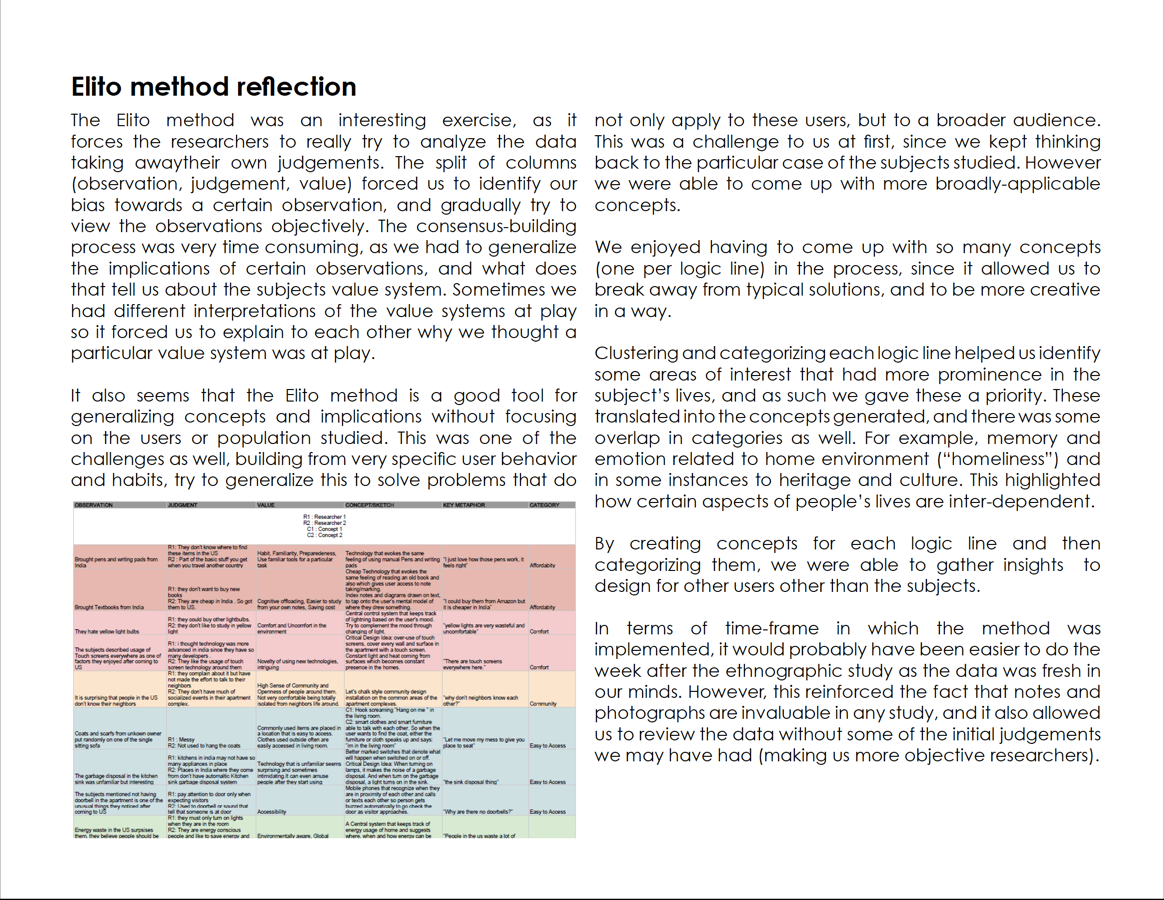
Slide title
6. Refelction
Button
Description
Ethnography is defined as “the art and science of describing a human group - its institutions, interpersonal behaviors, material productions, and beliefs”. It is a combination of observation, interview and participation.
Context
It can be used in situations when you don’t know much about the culture of your target user. Understand how things are done “over there”.
Methods Pairing
Goes with interviews, observation, shadowing and interaction.
Assignment Refelctions
From the readings, I understood ethnography as a long term research method where a researcher has to fully get involved in the user setting by being a part of the local group. I think the theoretical process of conducting an ethnographic study did not match with the process we followed for the assignment. For assignment, we had several limitations in terms of location and time. For our ethnographic study, we basically conducted a group interview in user setting which, I believe isn’t enough research. After the interview, we prepared a transcript for a small section of the process and submitted the assignment. I didn’t quite get the purpose of preparing transcript since we already had audio file of the interview to refer. I could relate ethnographic study with cultural probe since both are open ended research method where inspiration for design is primary motive. But, being an amateur, I am not sure of this inspirational process yet.
Contextual Inquiry
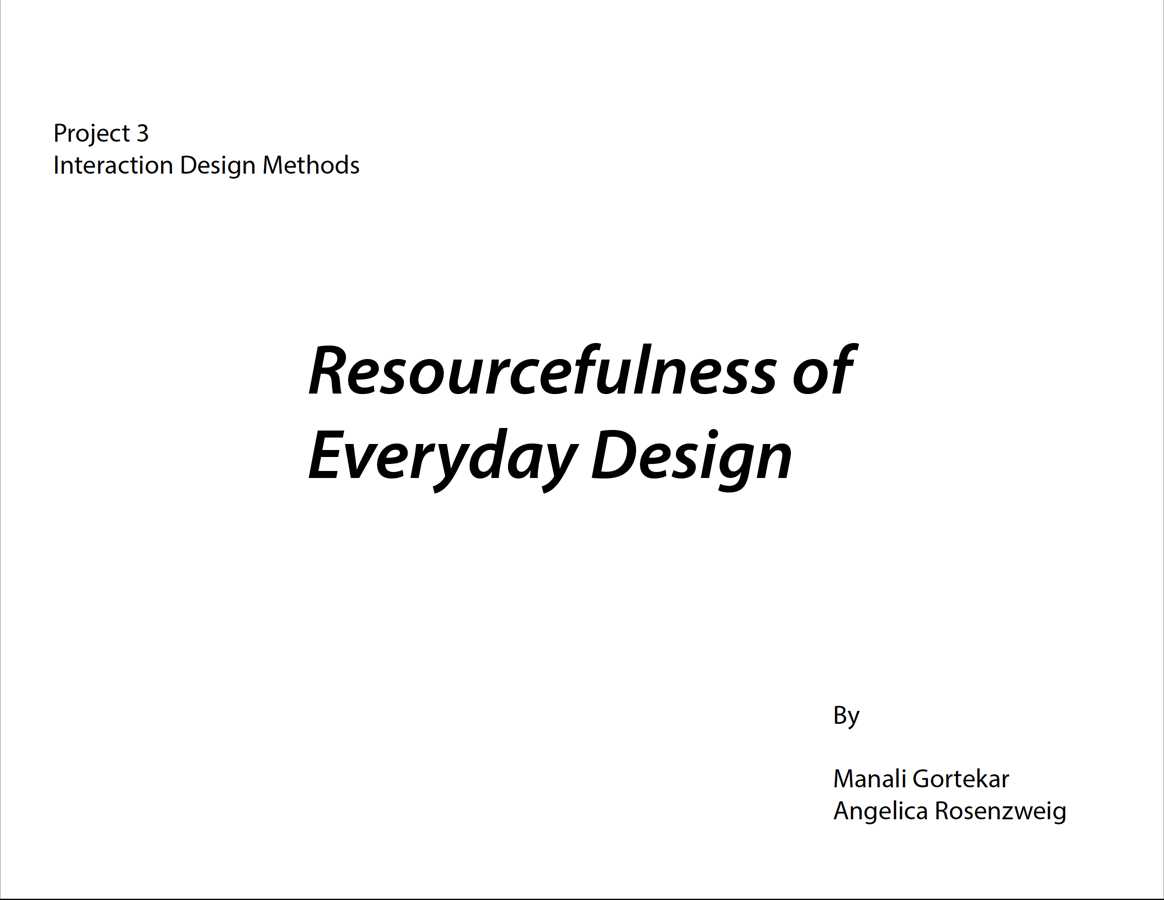
Slide title
1. Contextual Inquiry Prompt
Button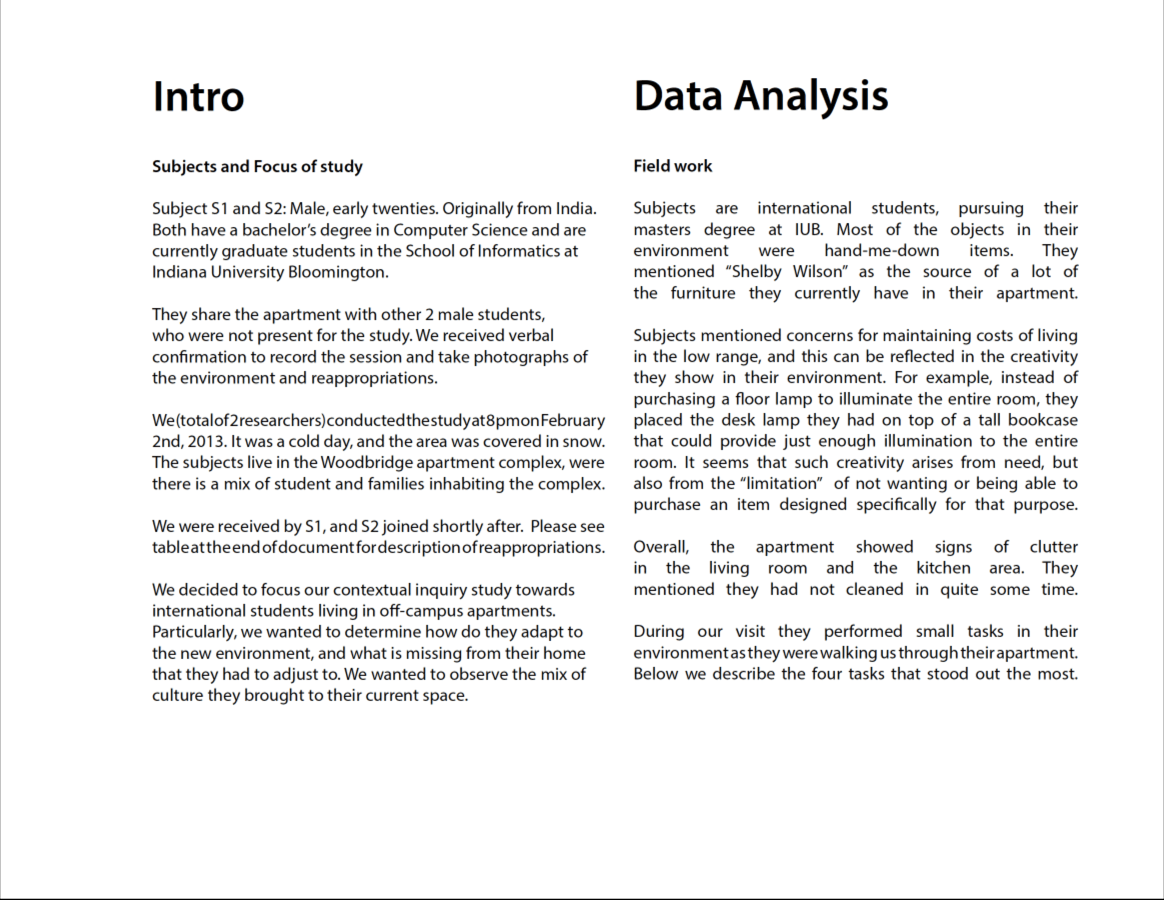
Slide title
2. Introduction
Button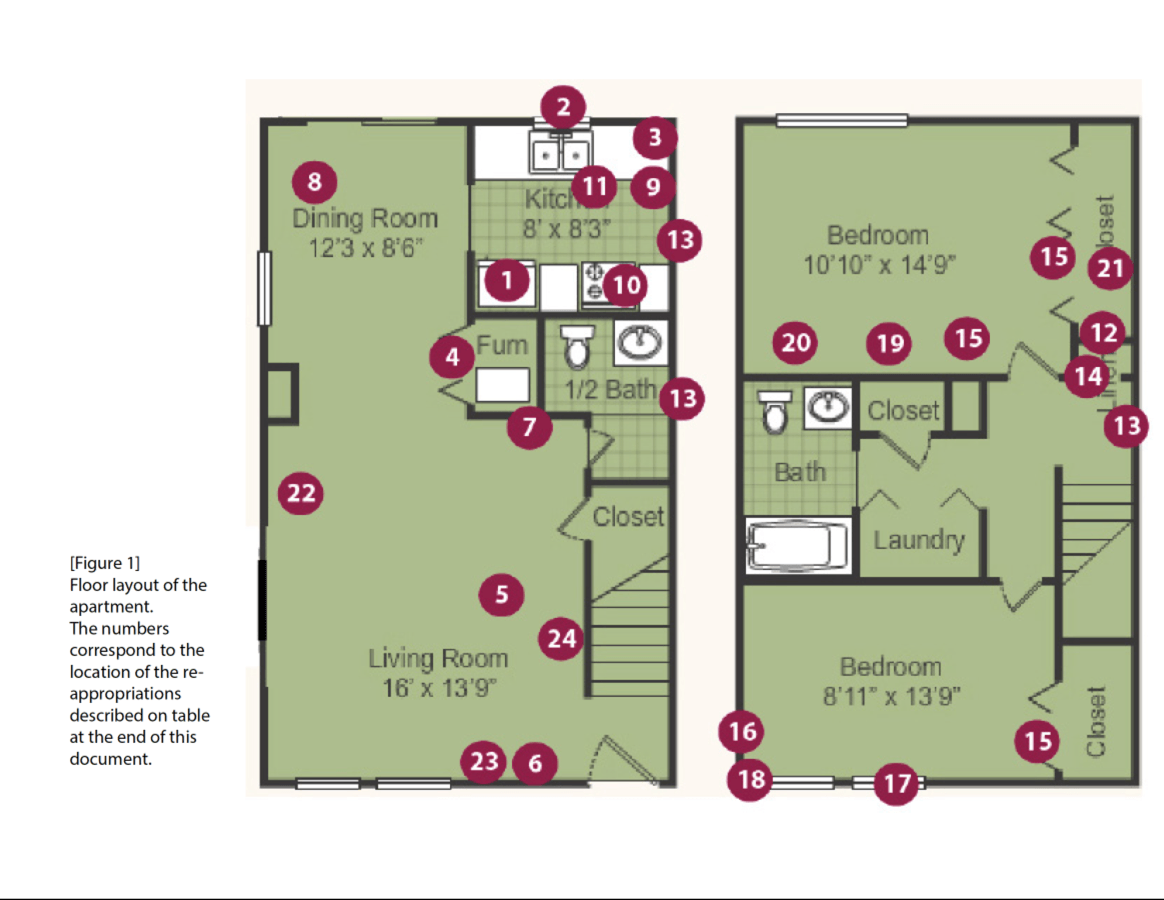
Slide title
3. Field Research
Button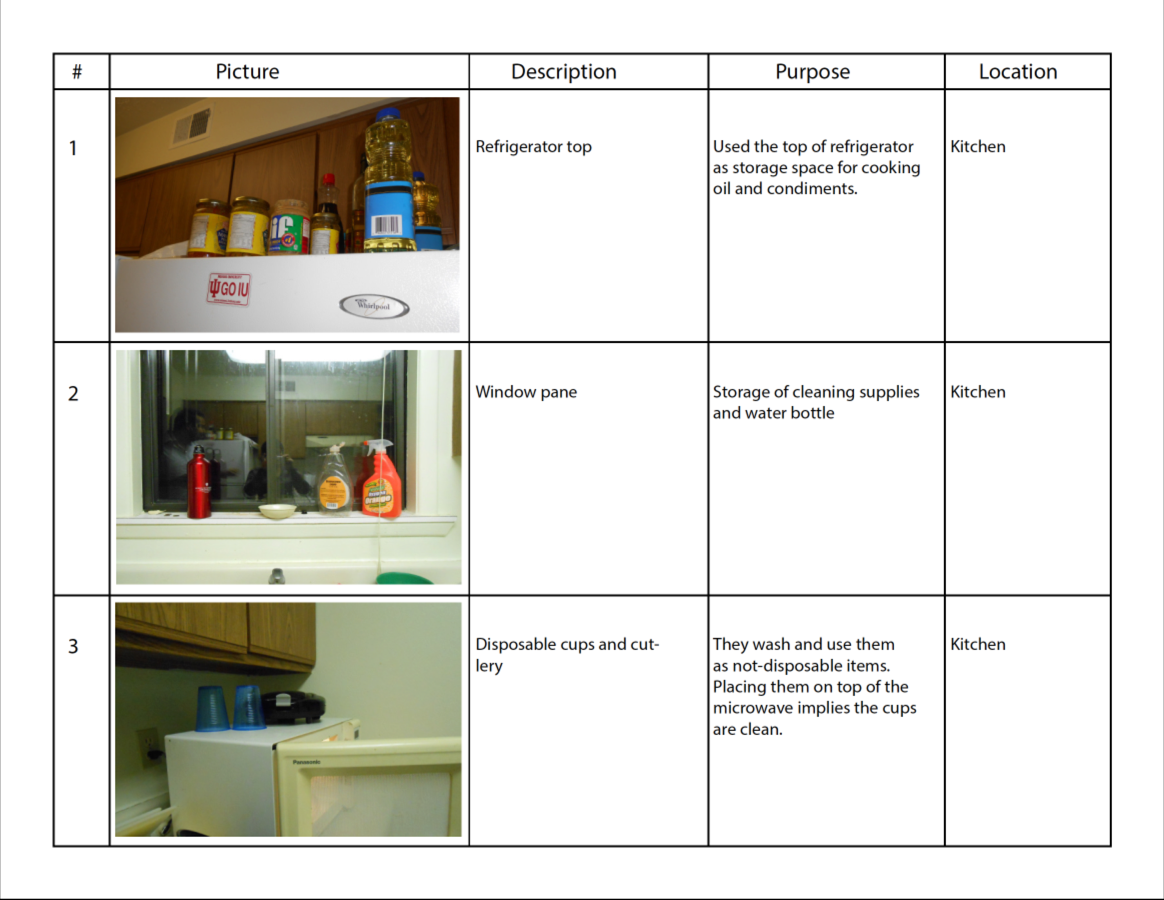
Slide title
4. Data Collection
Button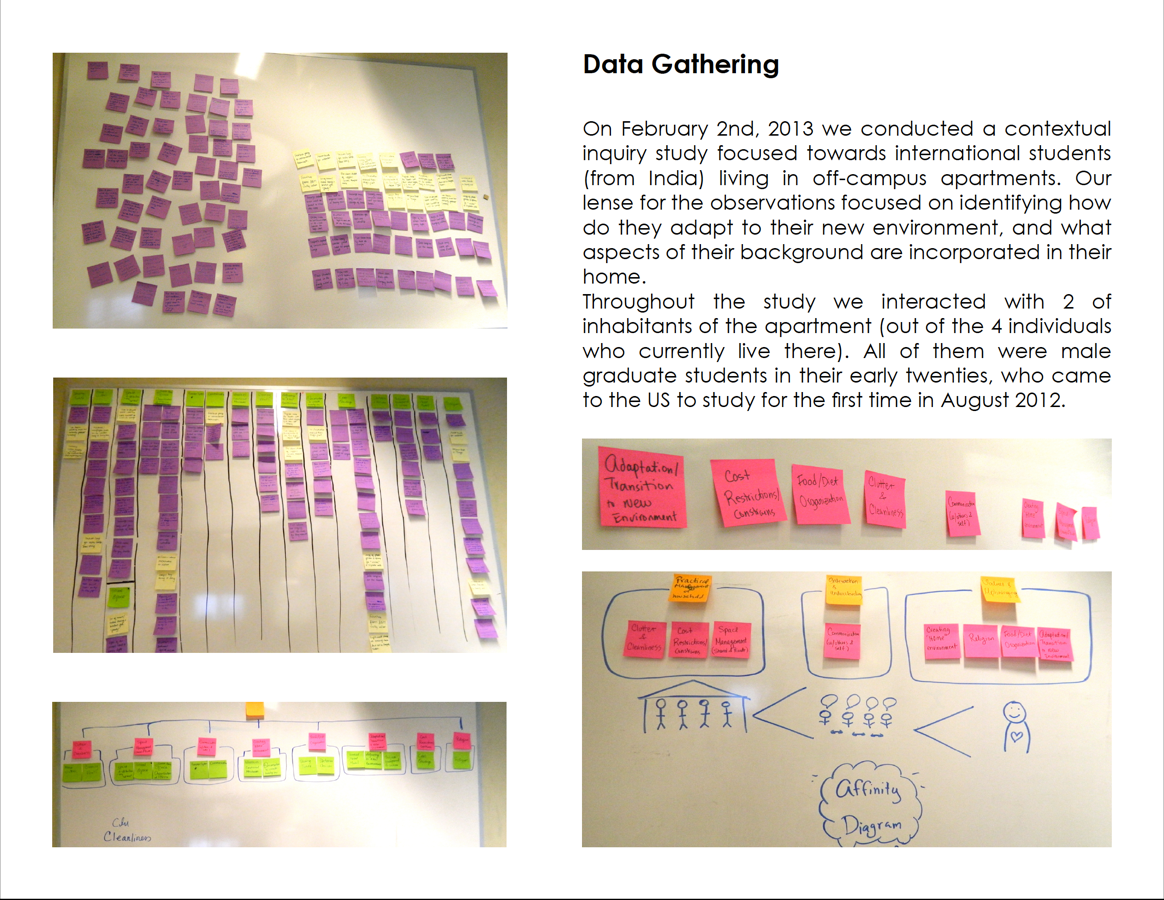
Slide title
5. Data Gathering and Analysis
Button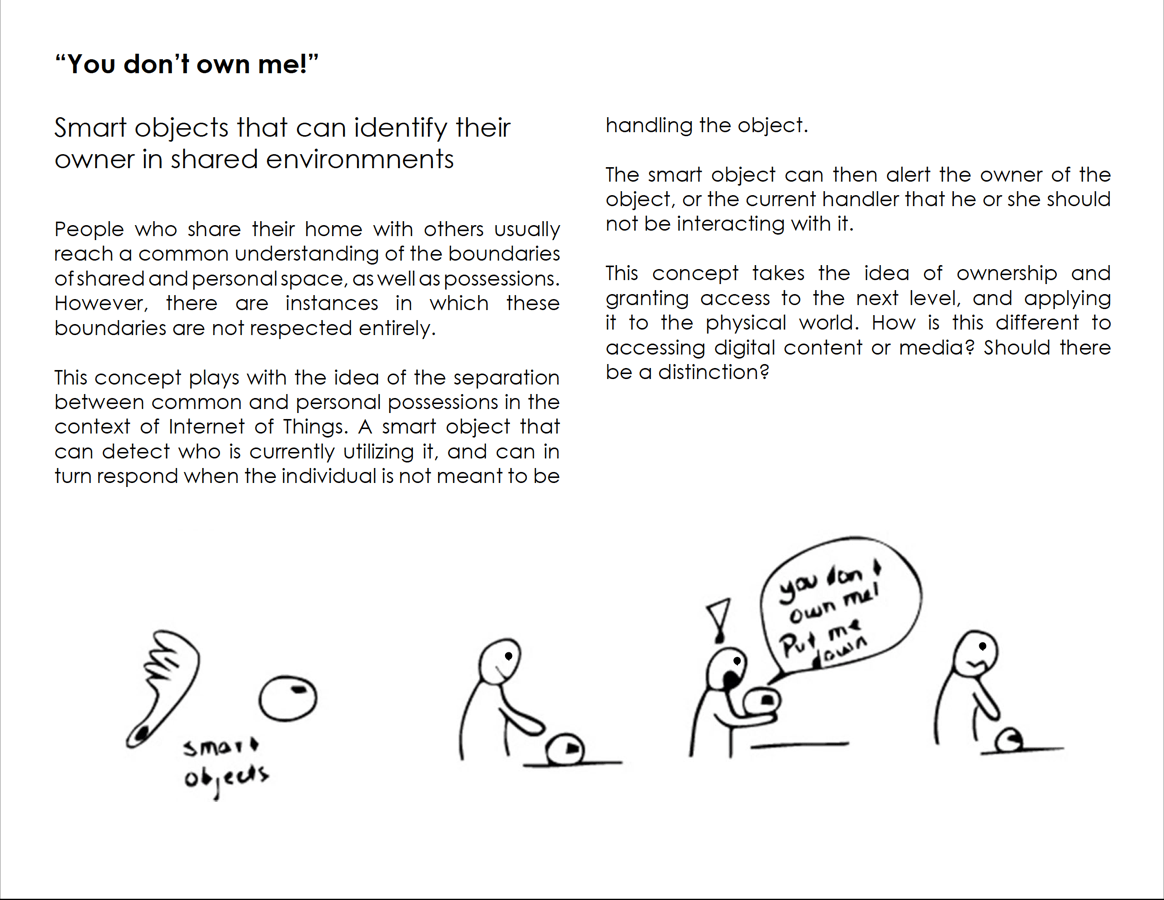
Slide title
6. Concept Sketching
Button
Description
Contextual Inquiry is a data gathering technique that studies a few carefully selected individuals in depth to arrive at a fuller understanding of the work practice across all customers. Through inquiry and interpretation, it reveals commonalities across a system’s customer base. It is an efficient way to know how the target audience's lives, how they think and what problems they run into in their daily lives.
Context
It can be used in situations where the actual problem needs to be discovered. The method gives insights on situations in which problems occur and how people try to solve them.
Methods Pairing
Goes with Visual Ethnography.
Assignment Refelctions
I think contextual inquiry was very effective in terms of understanding users - their habits, routine and general atmosphere of the setting. While doing the assignment, it was interesting to observe several appropriations by users. It gave me insight of how a normal user can be a designer in his own way. The appropriations strike up an interesting conversation between researchers and subjects. It was fascinating to know the unsaid arrangements our subjects did within themselves. The notion of “Who is being provoked” came out while practicing this method.

